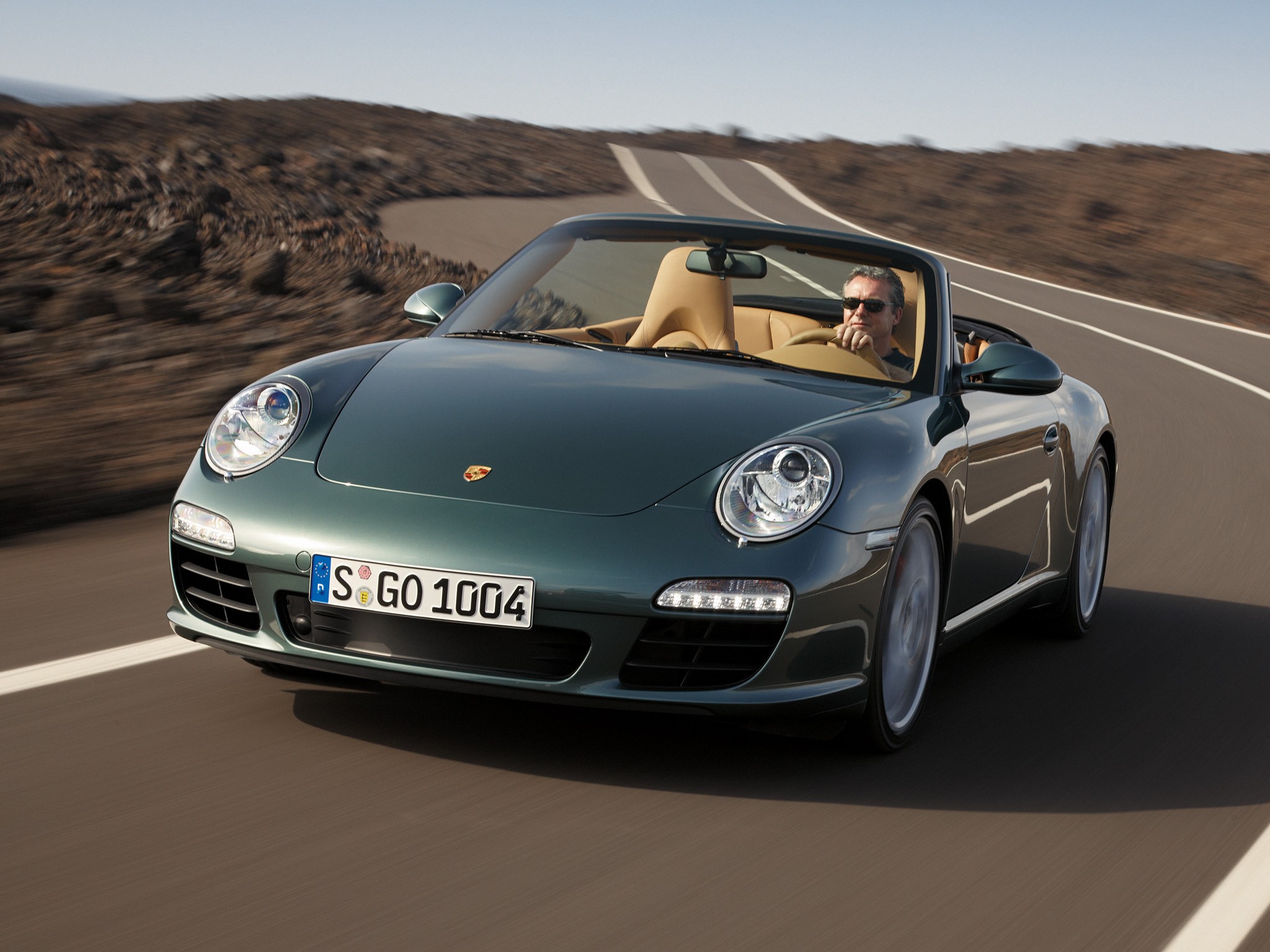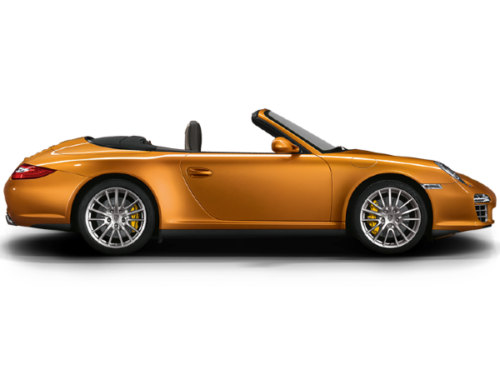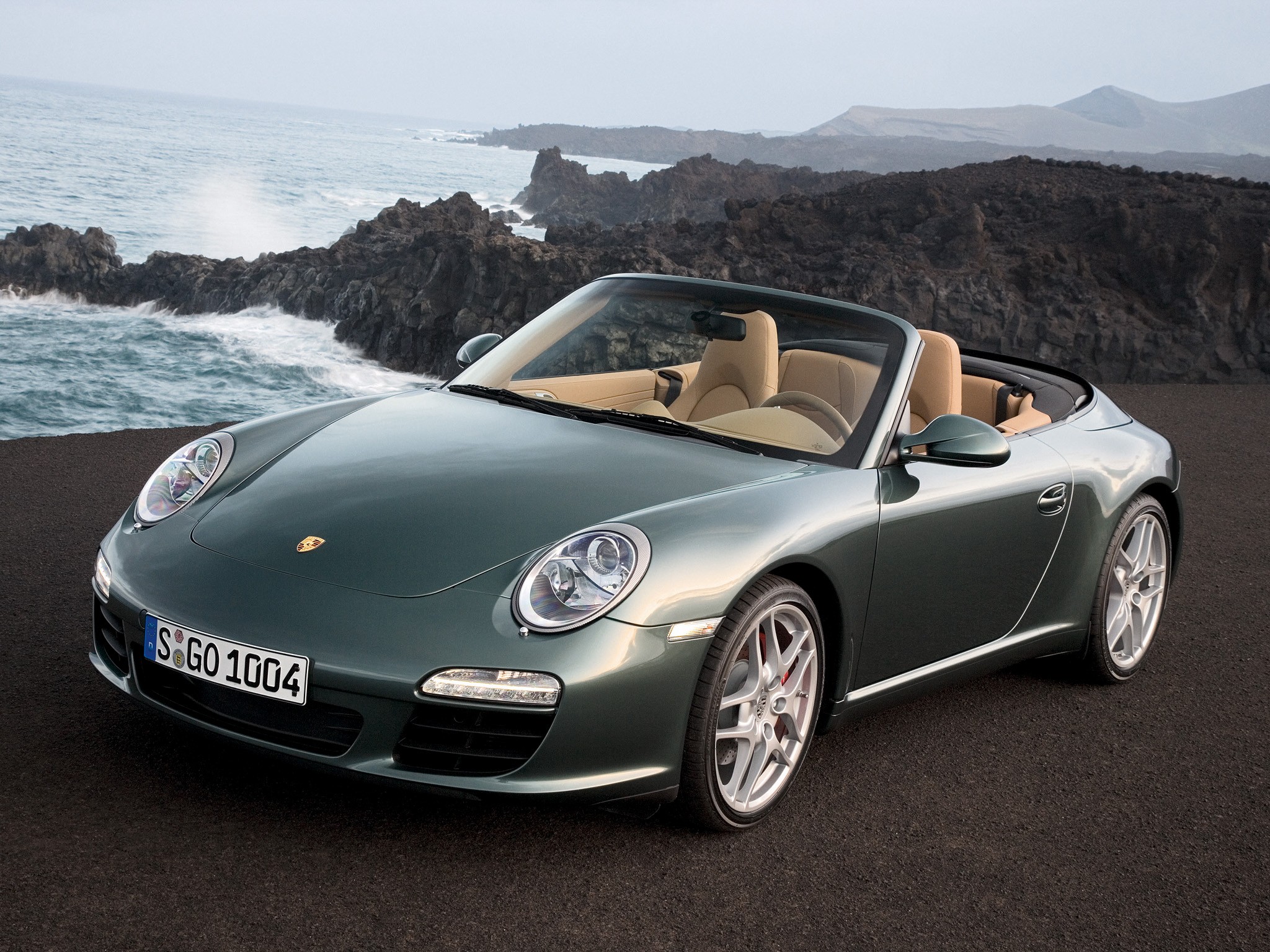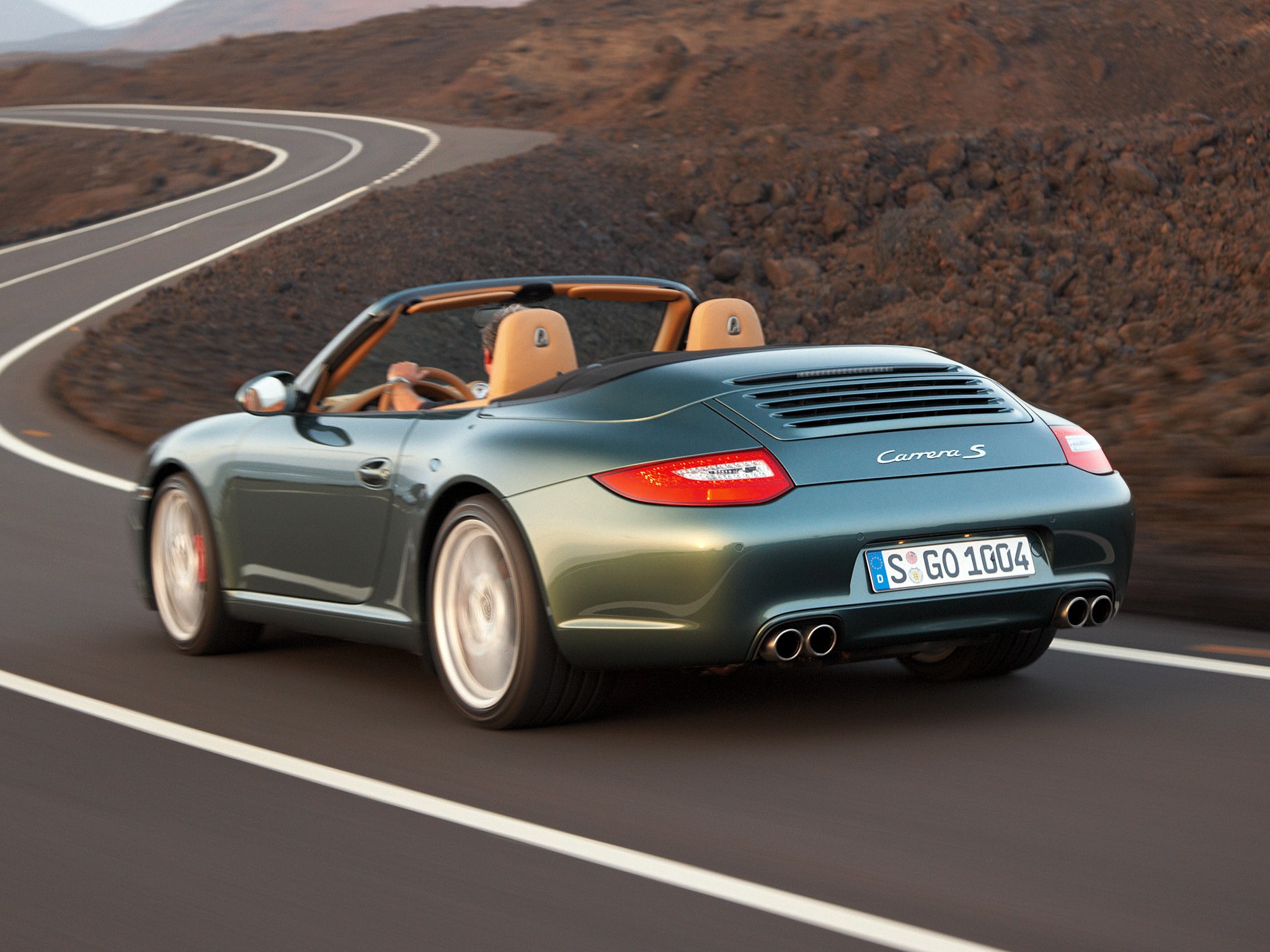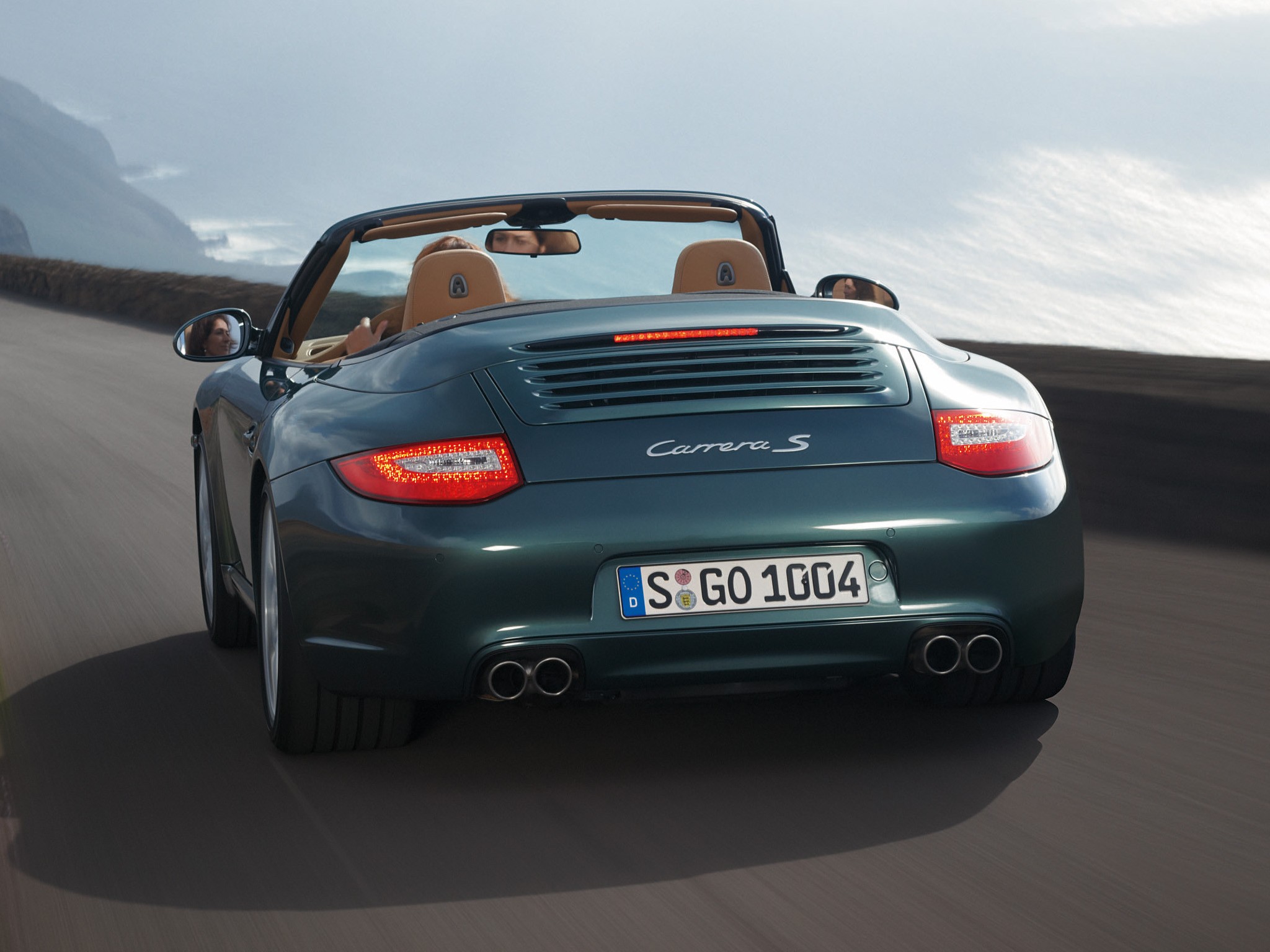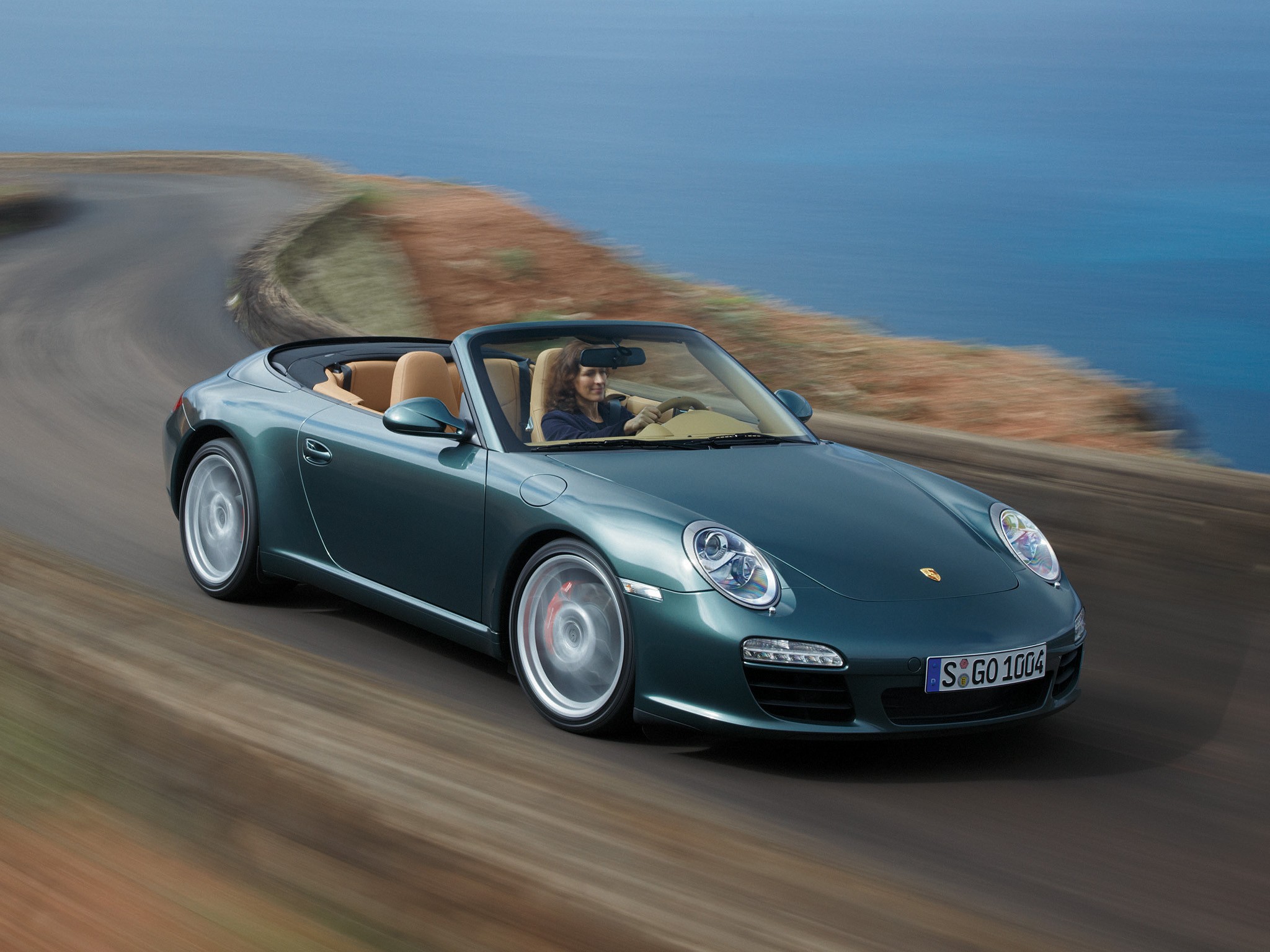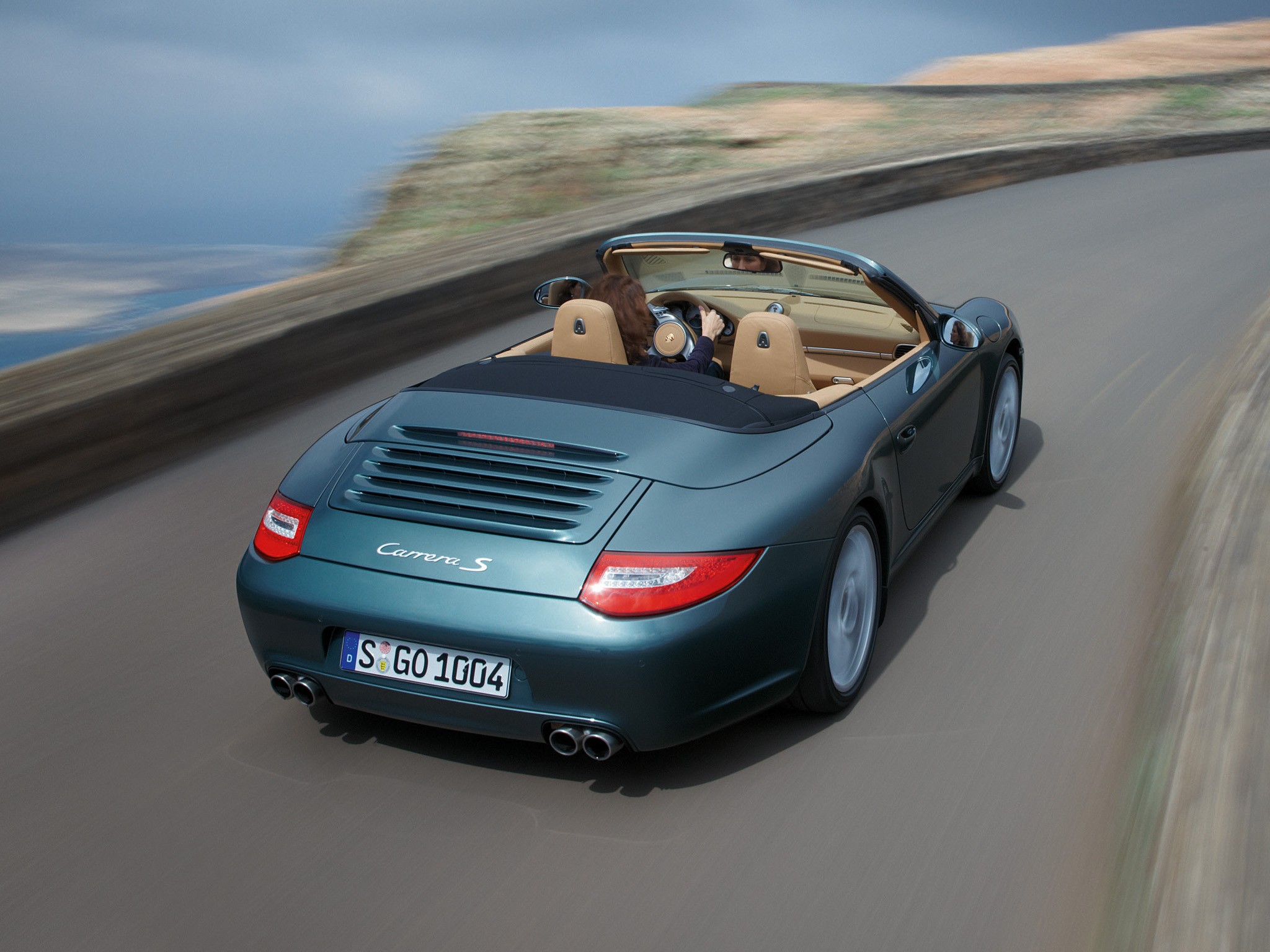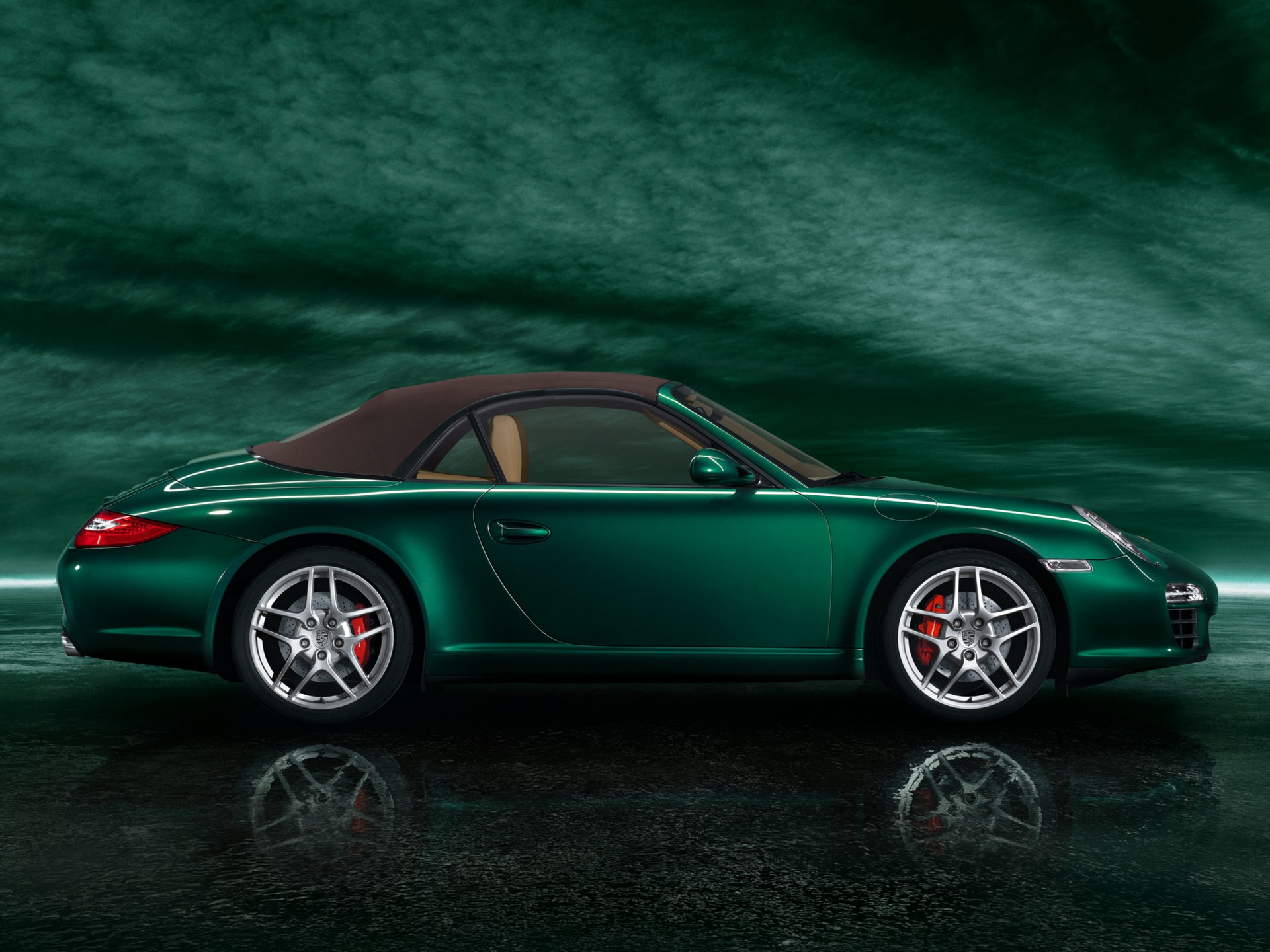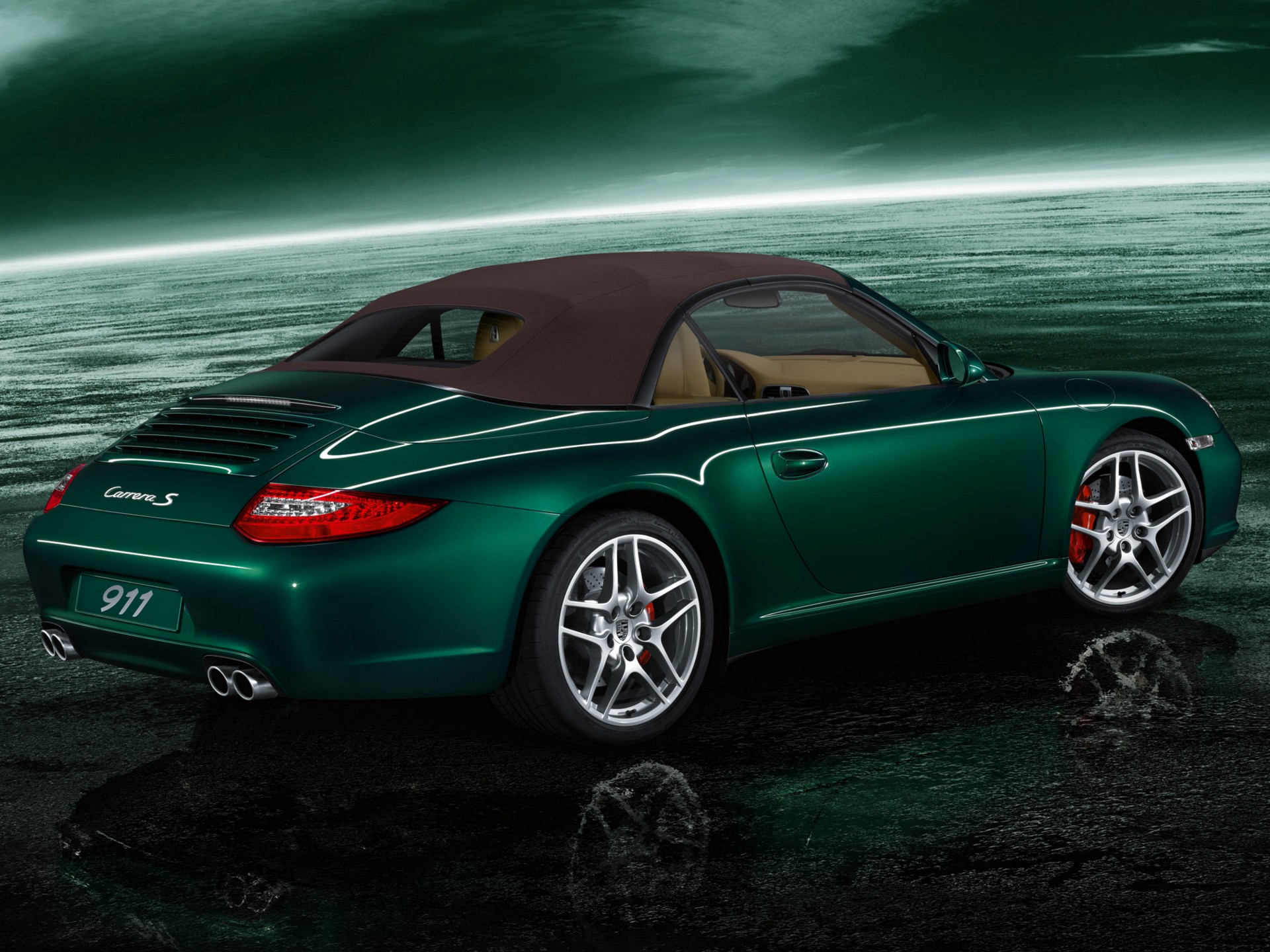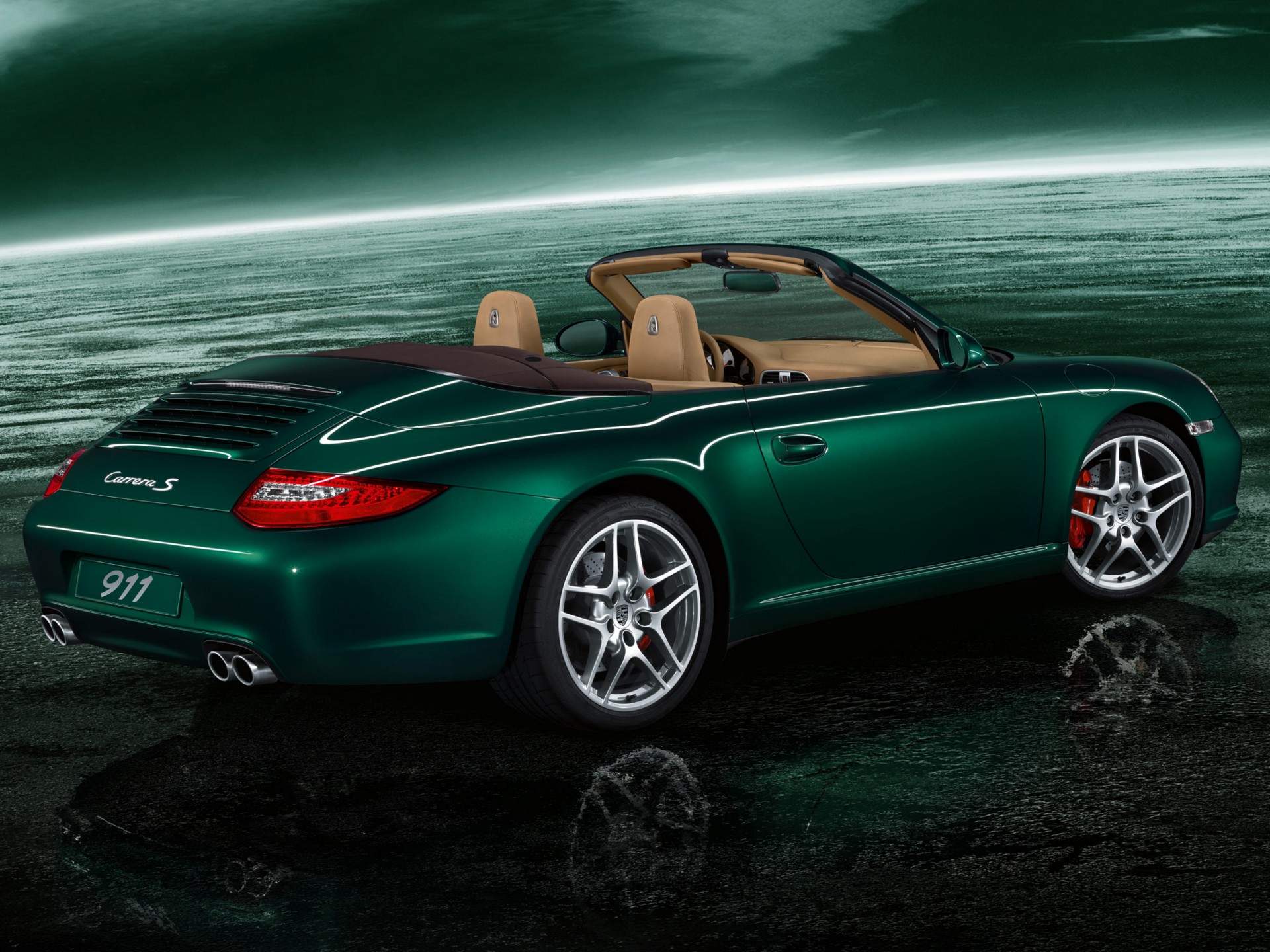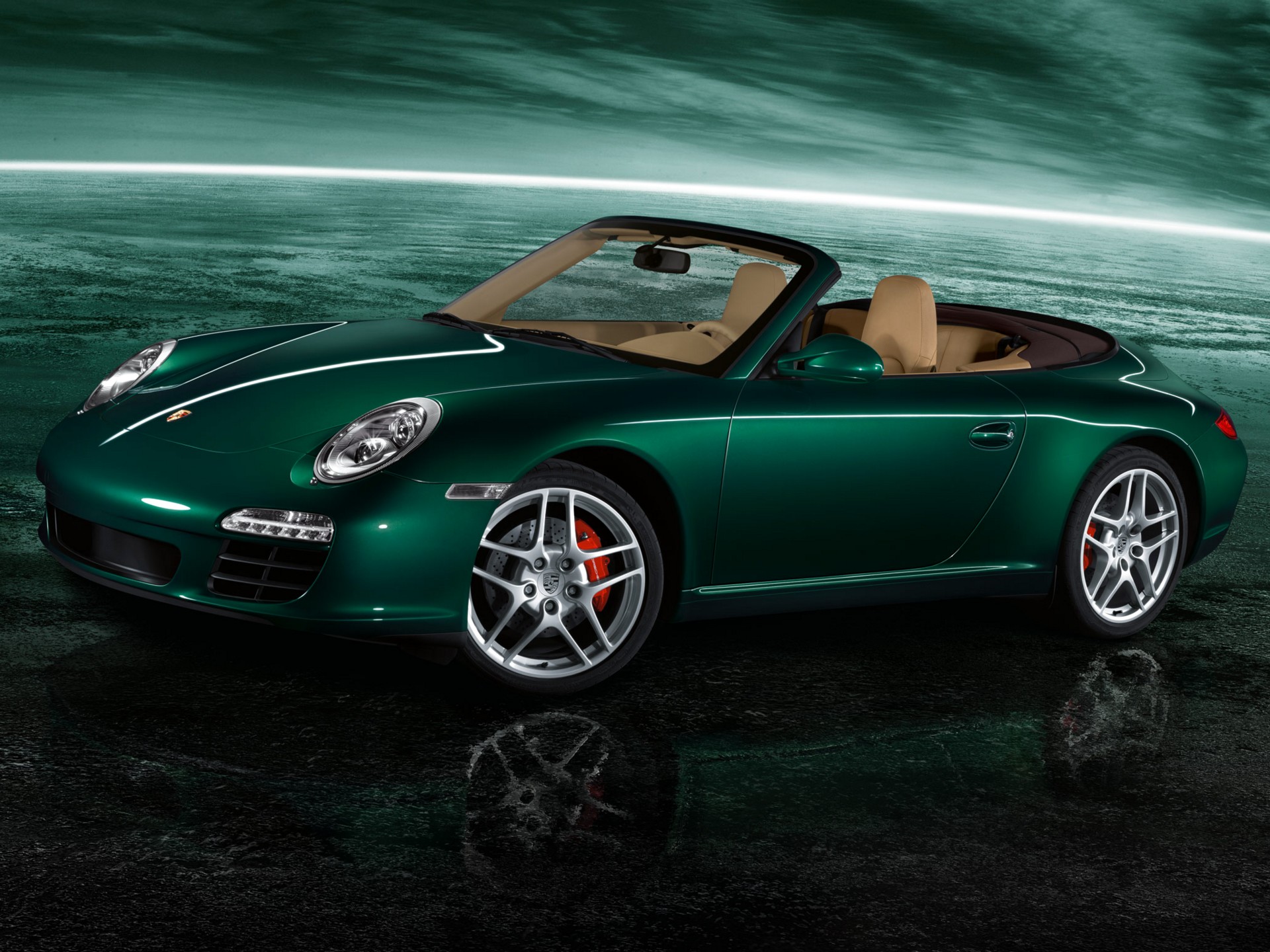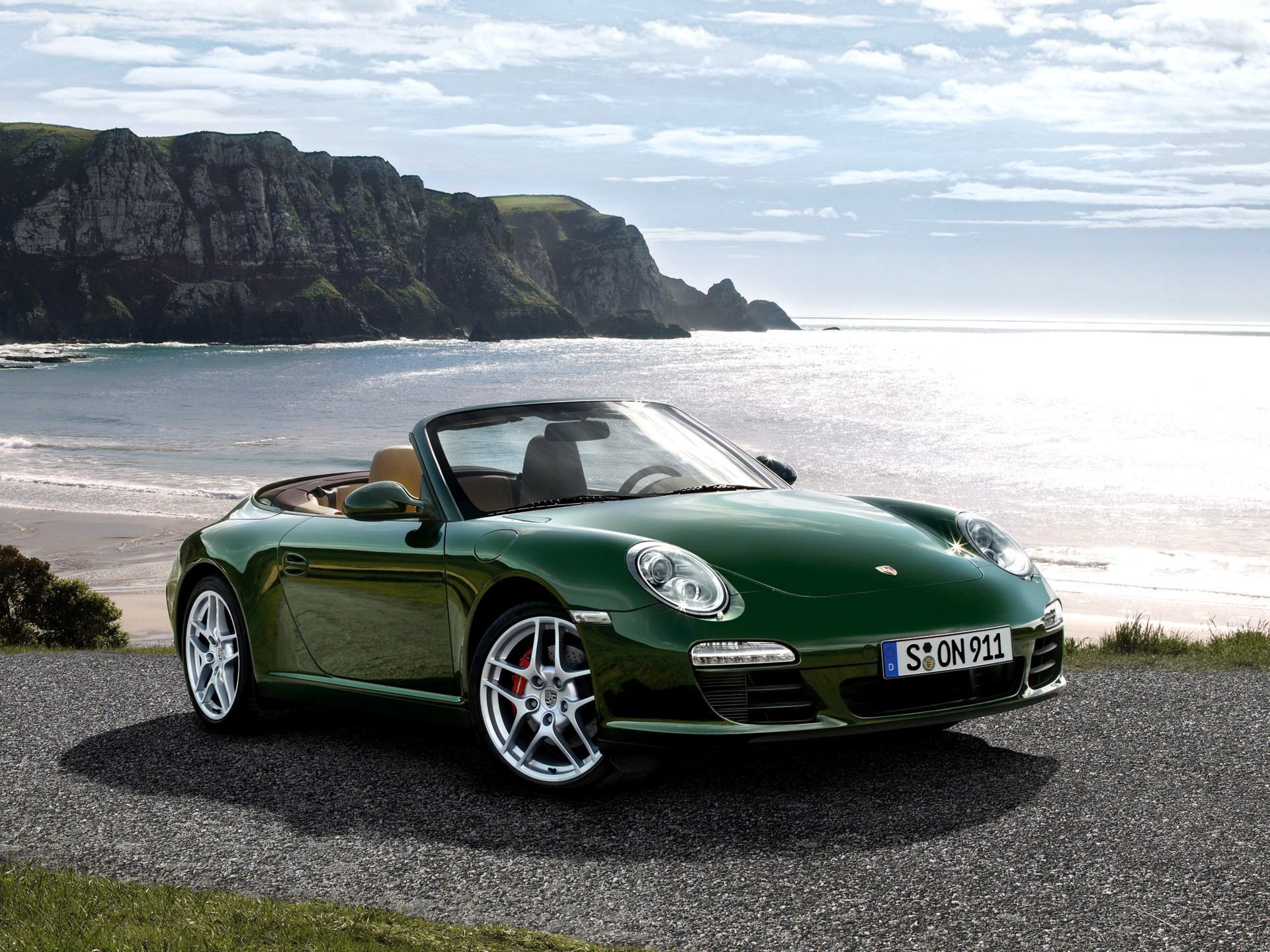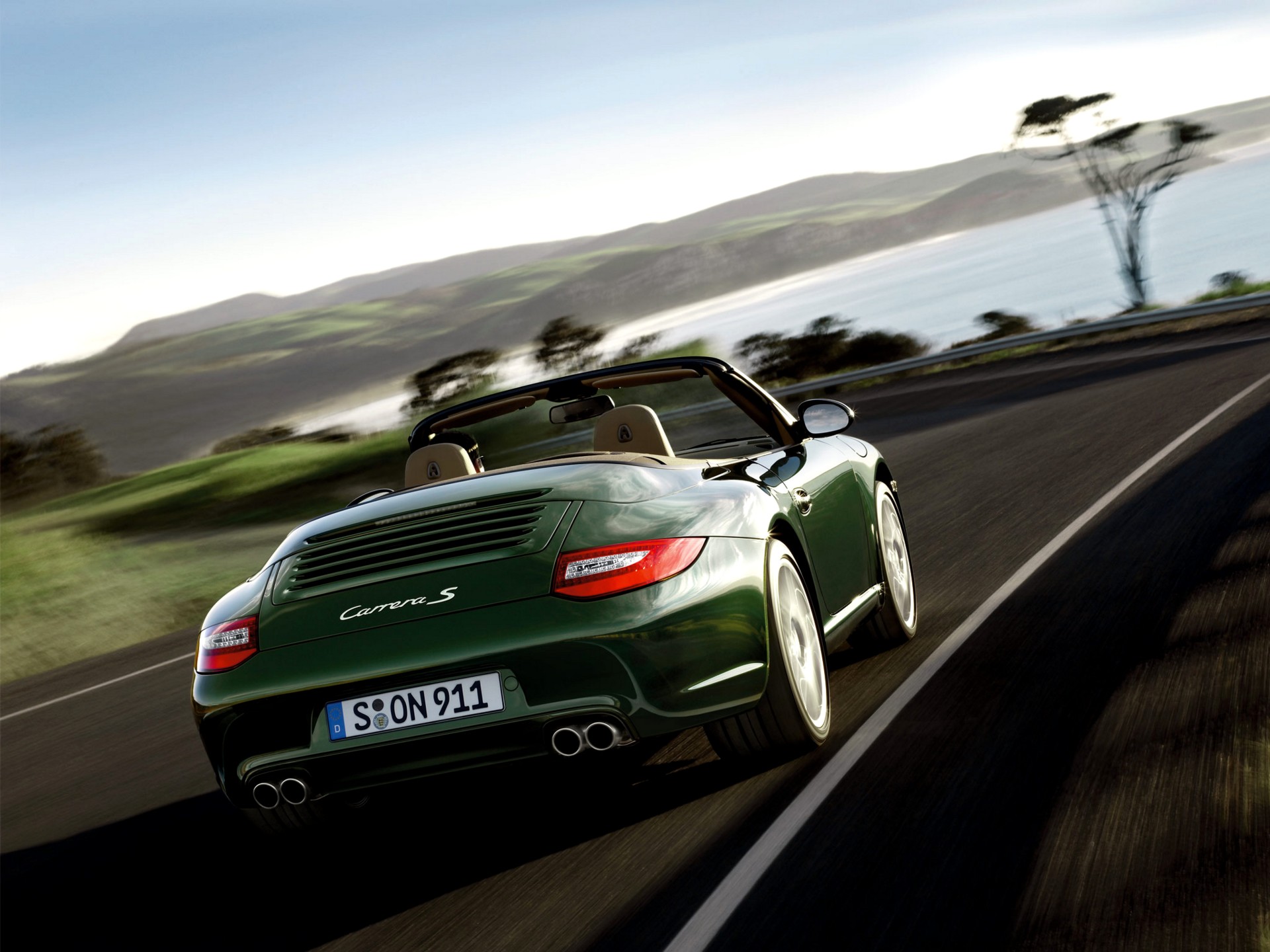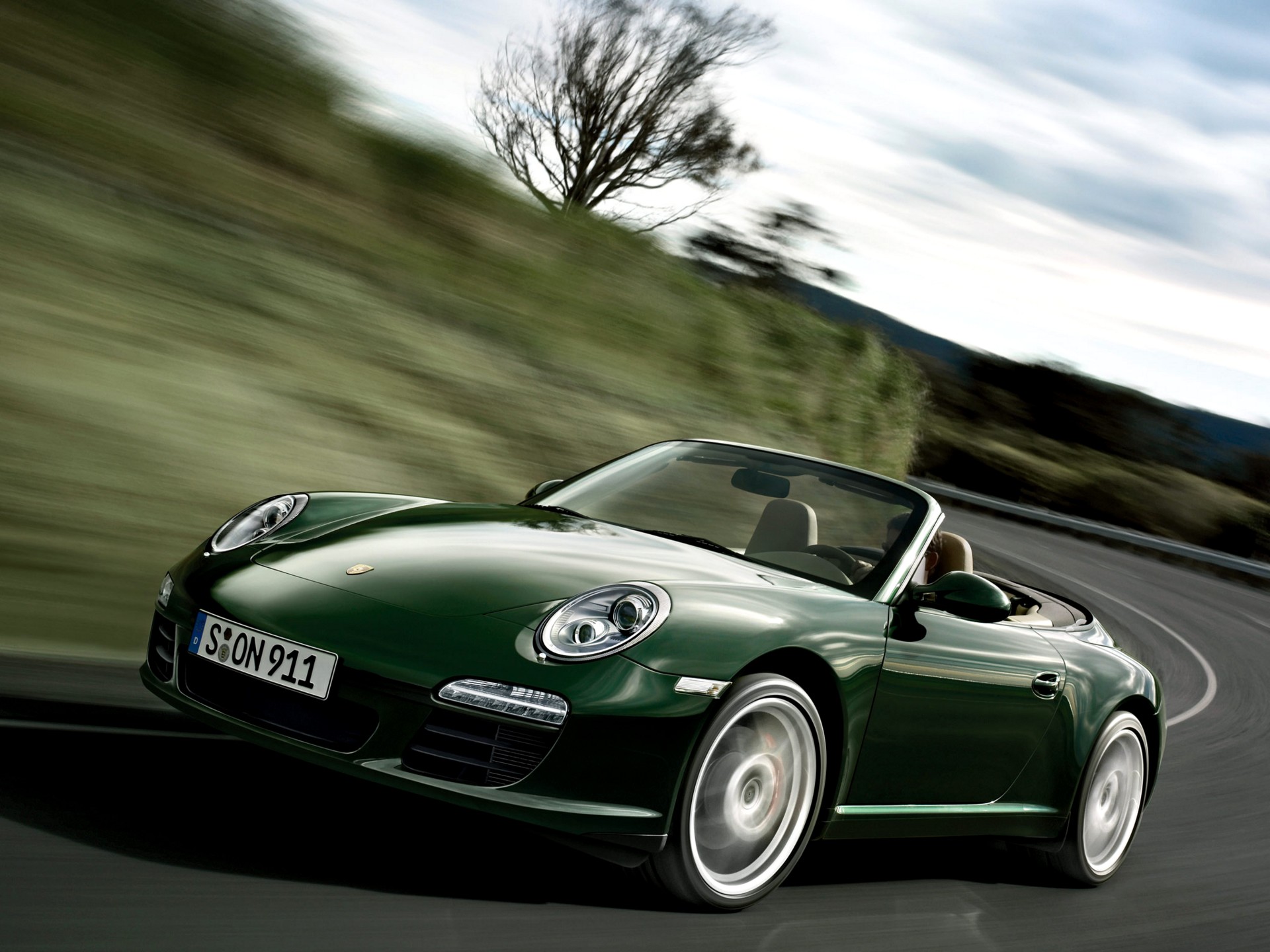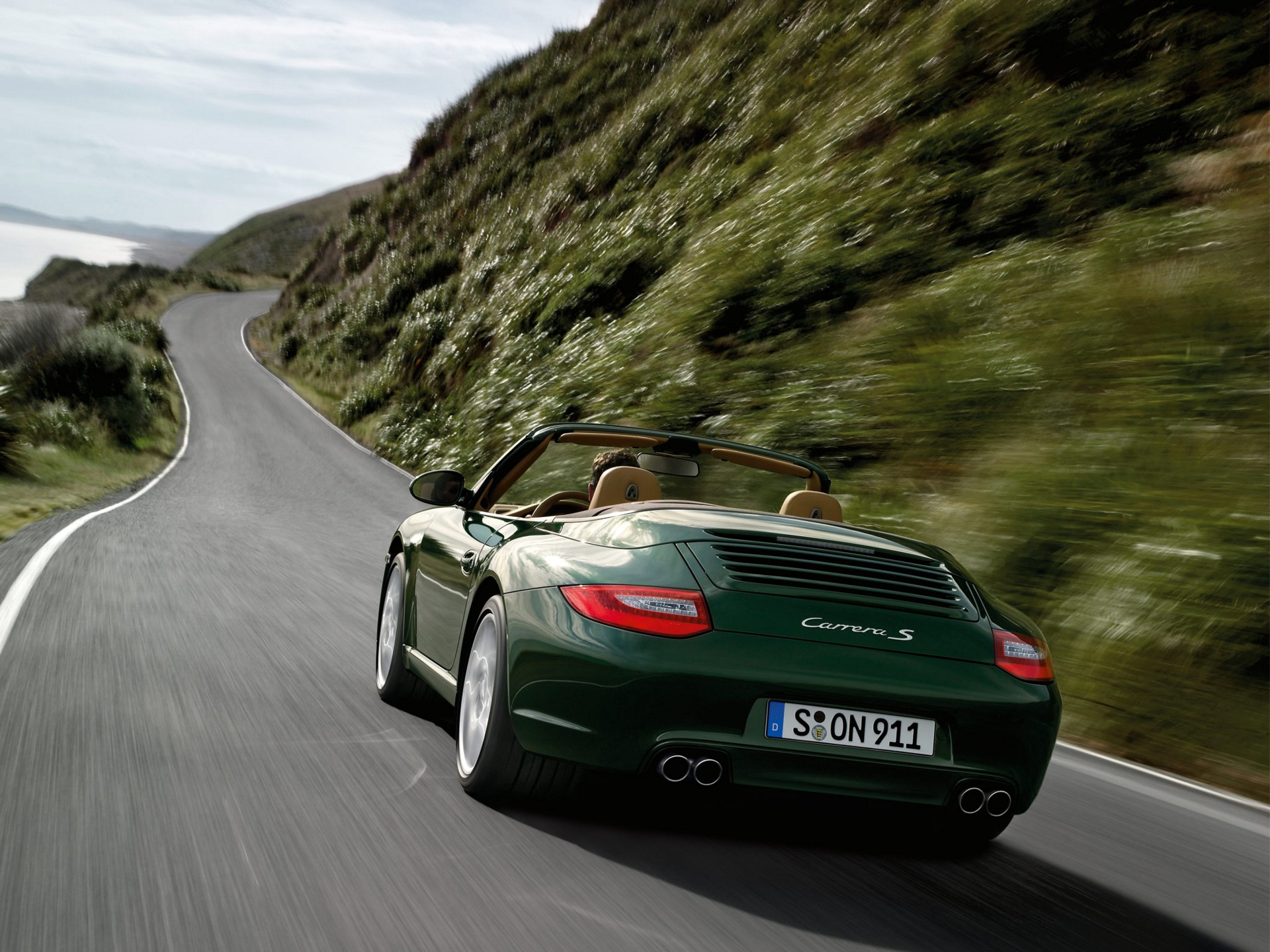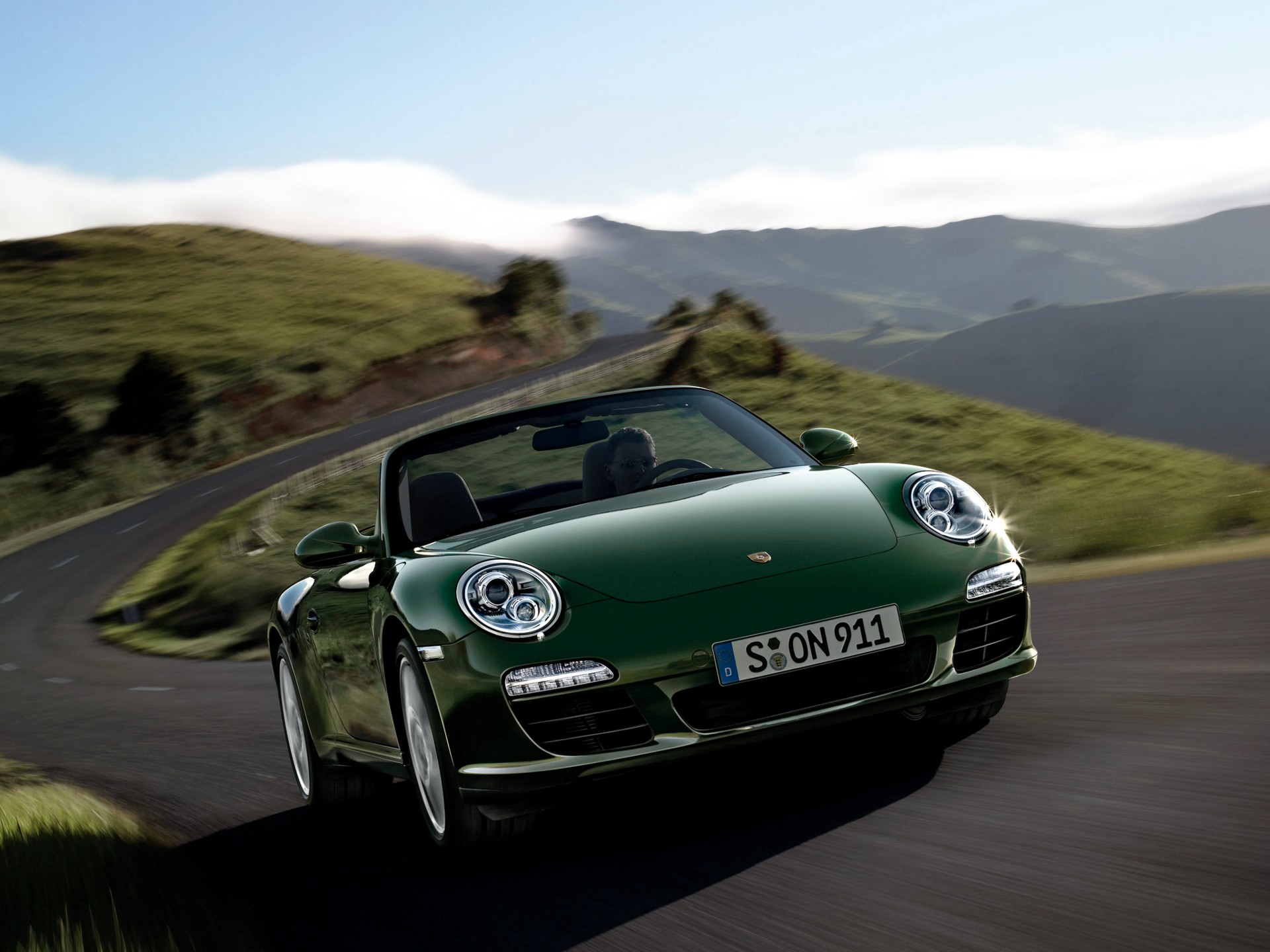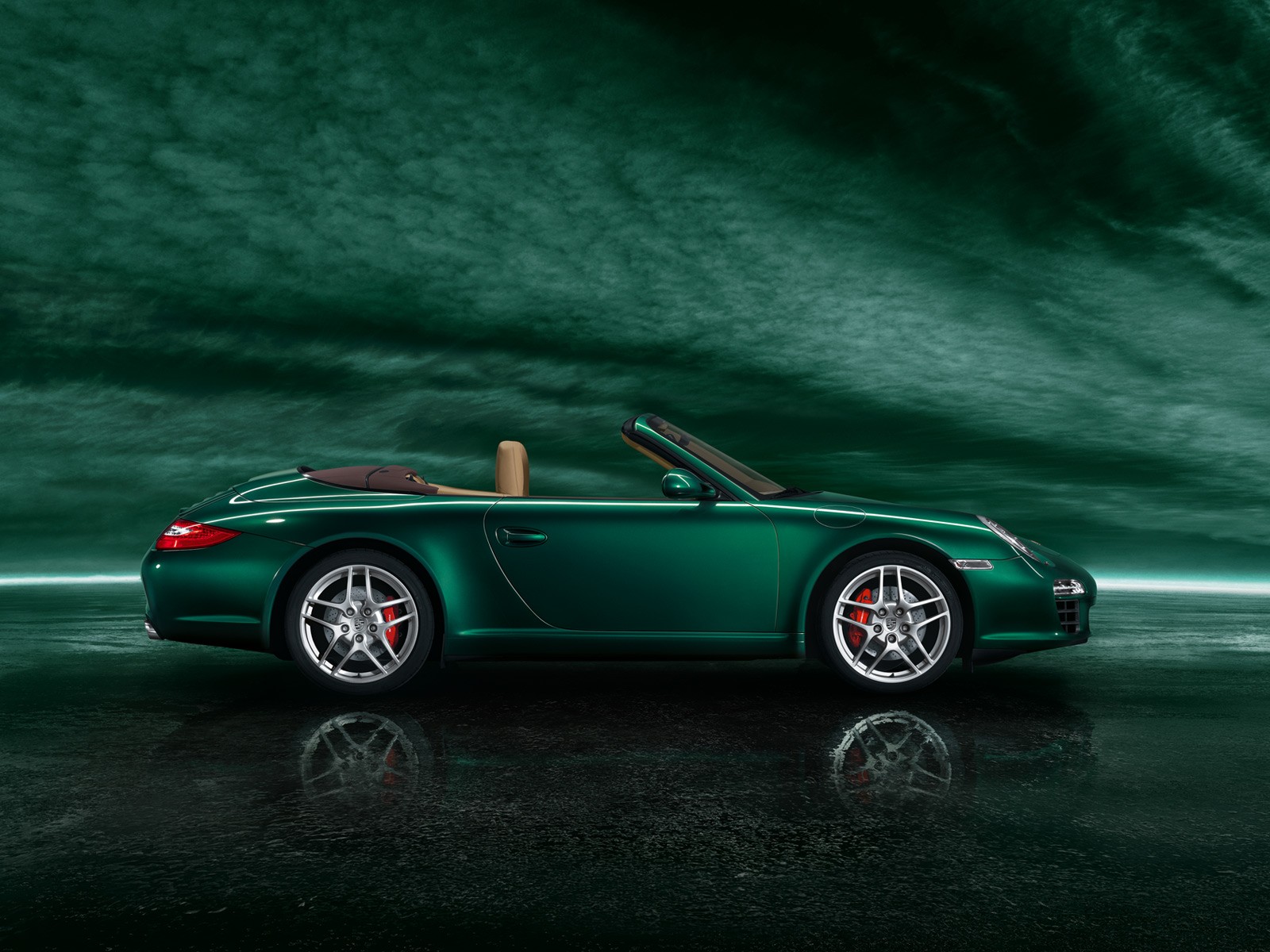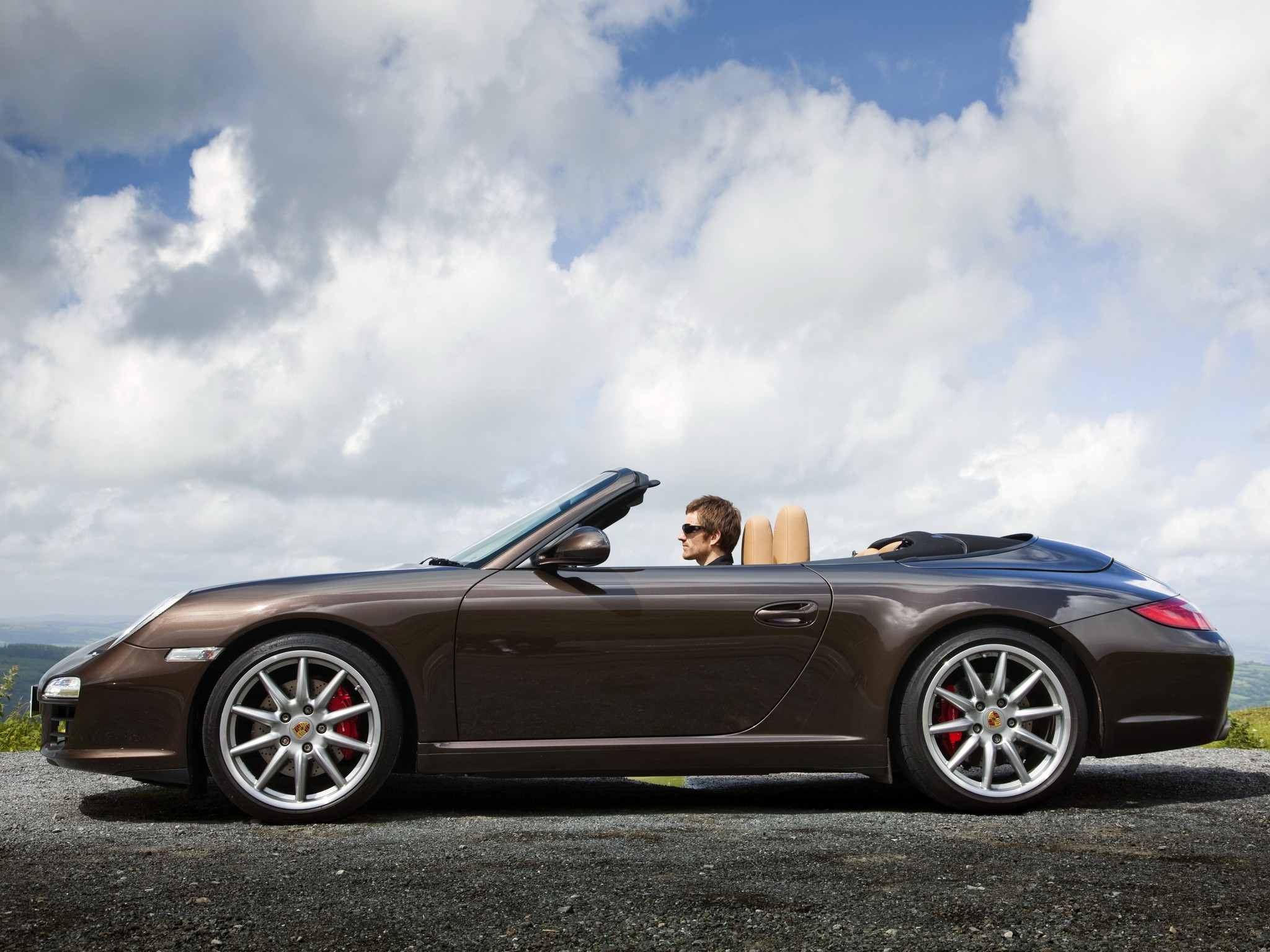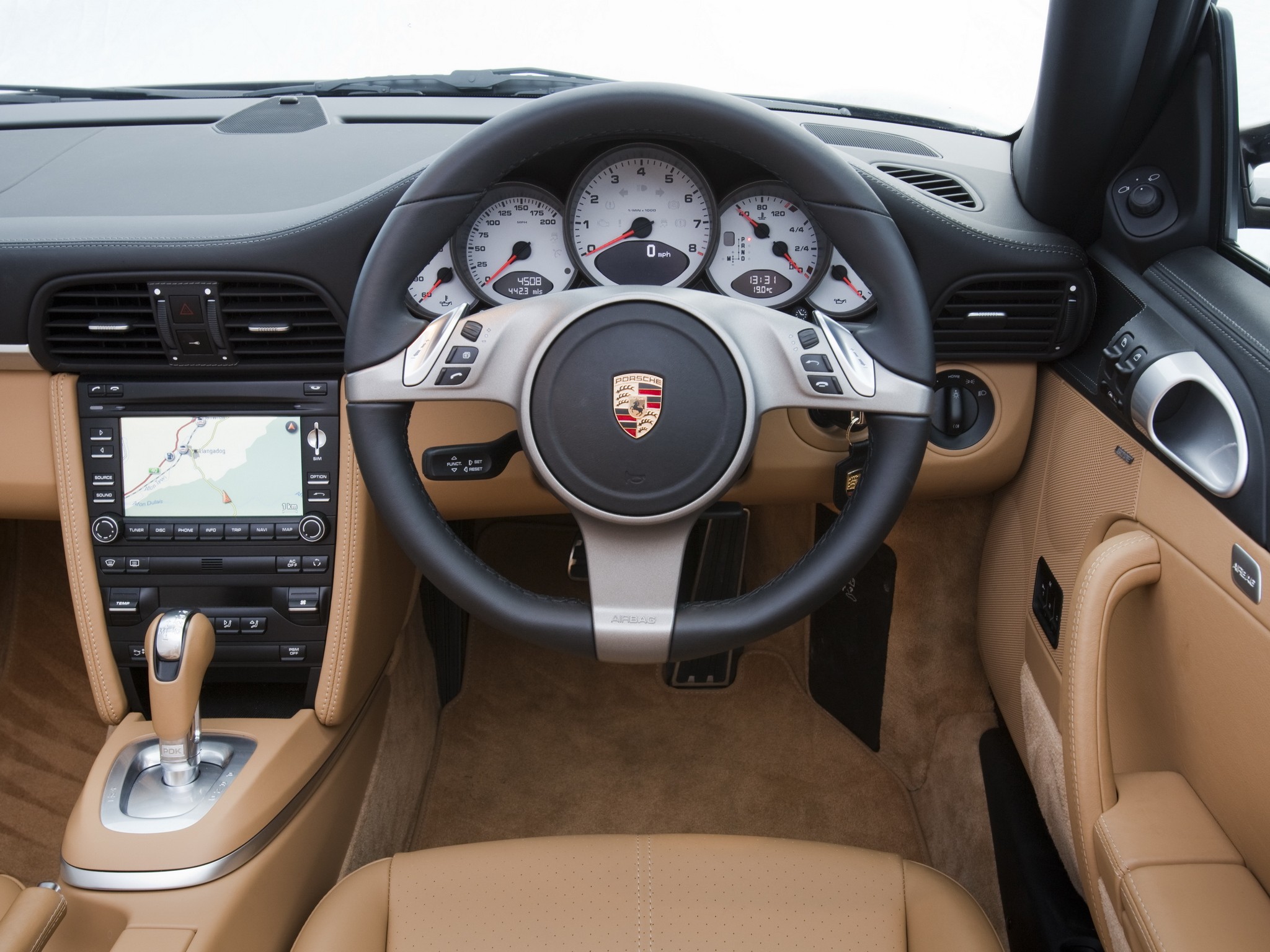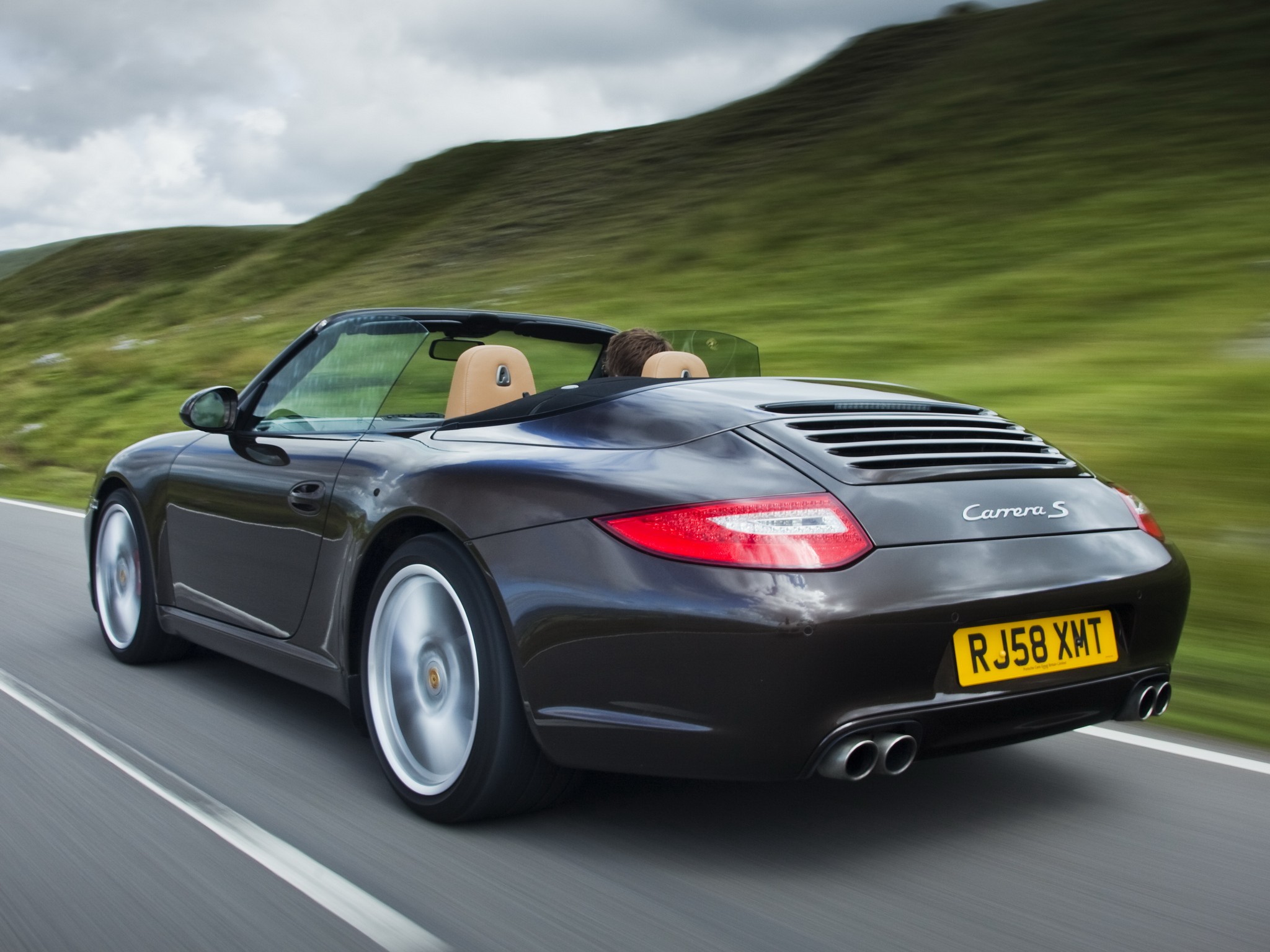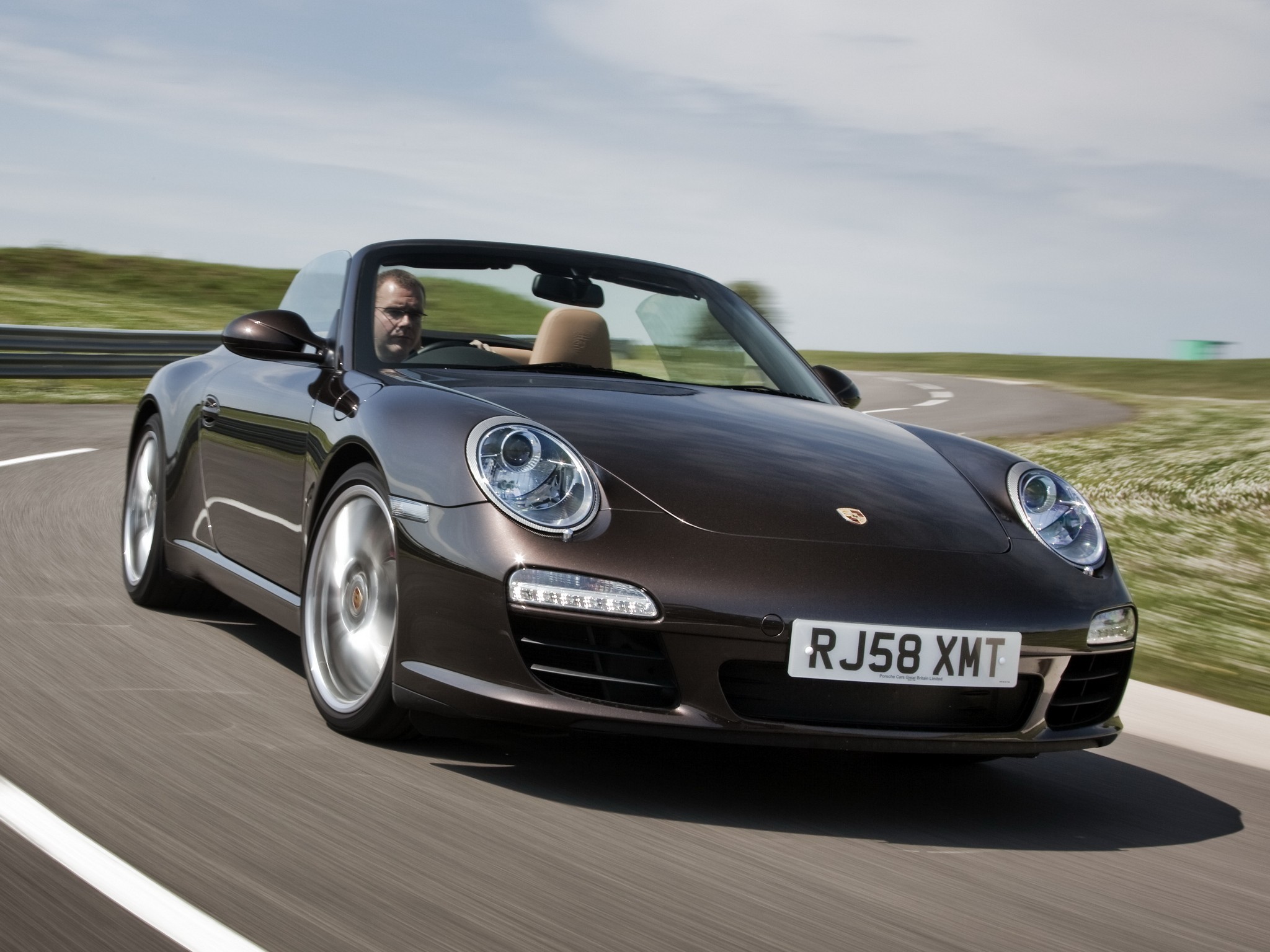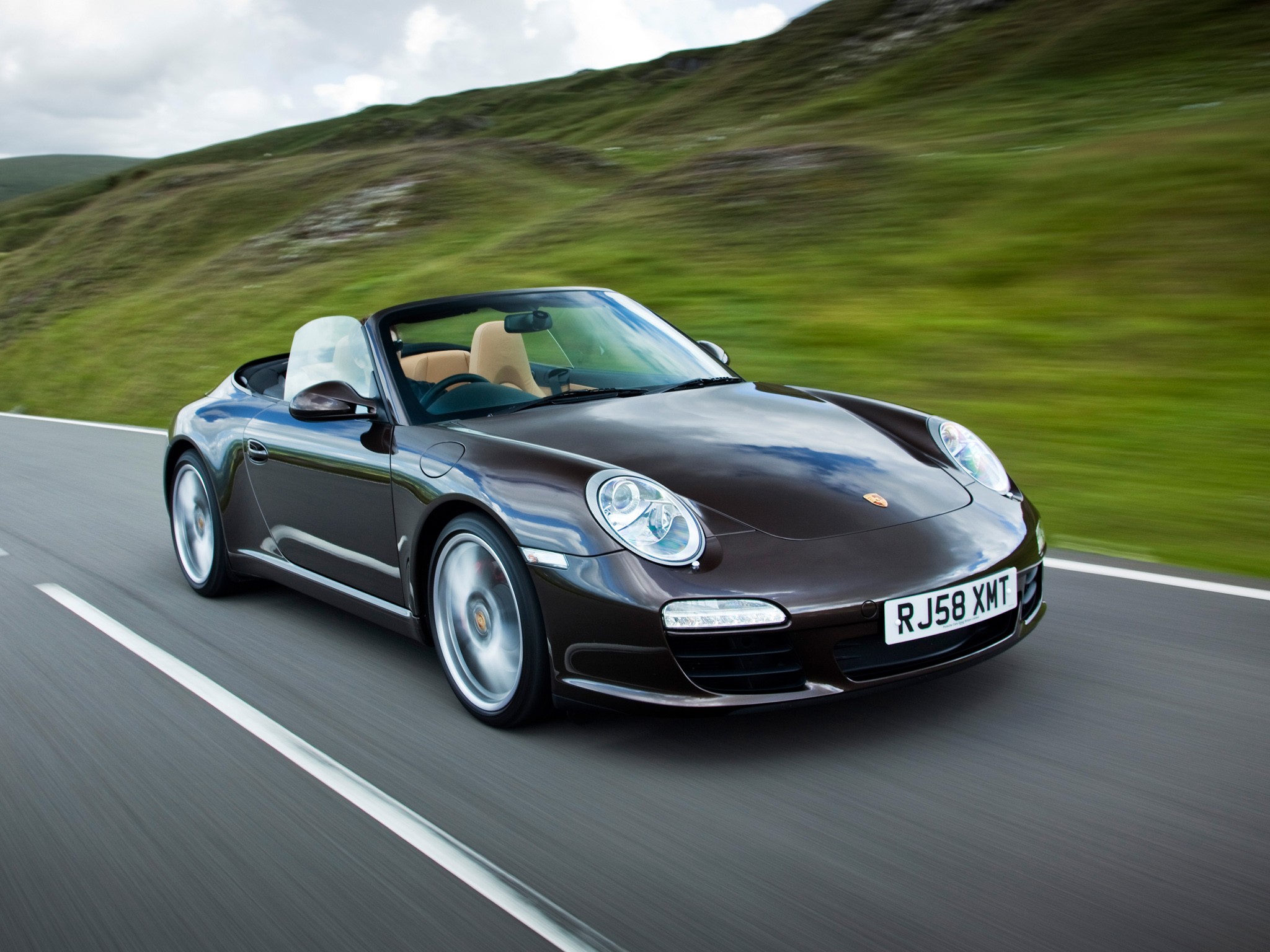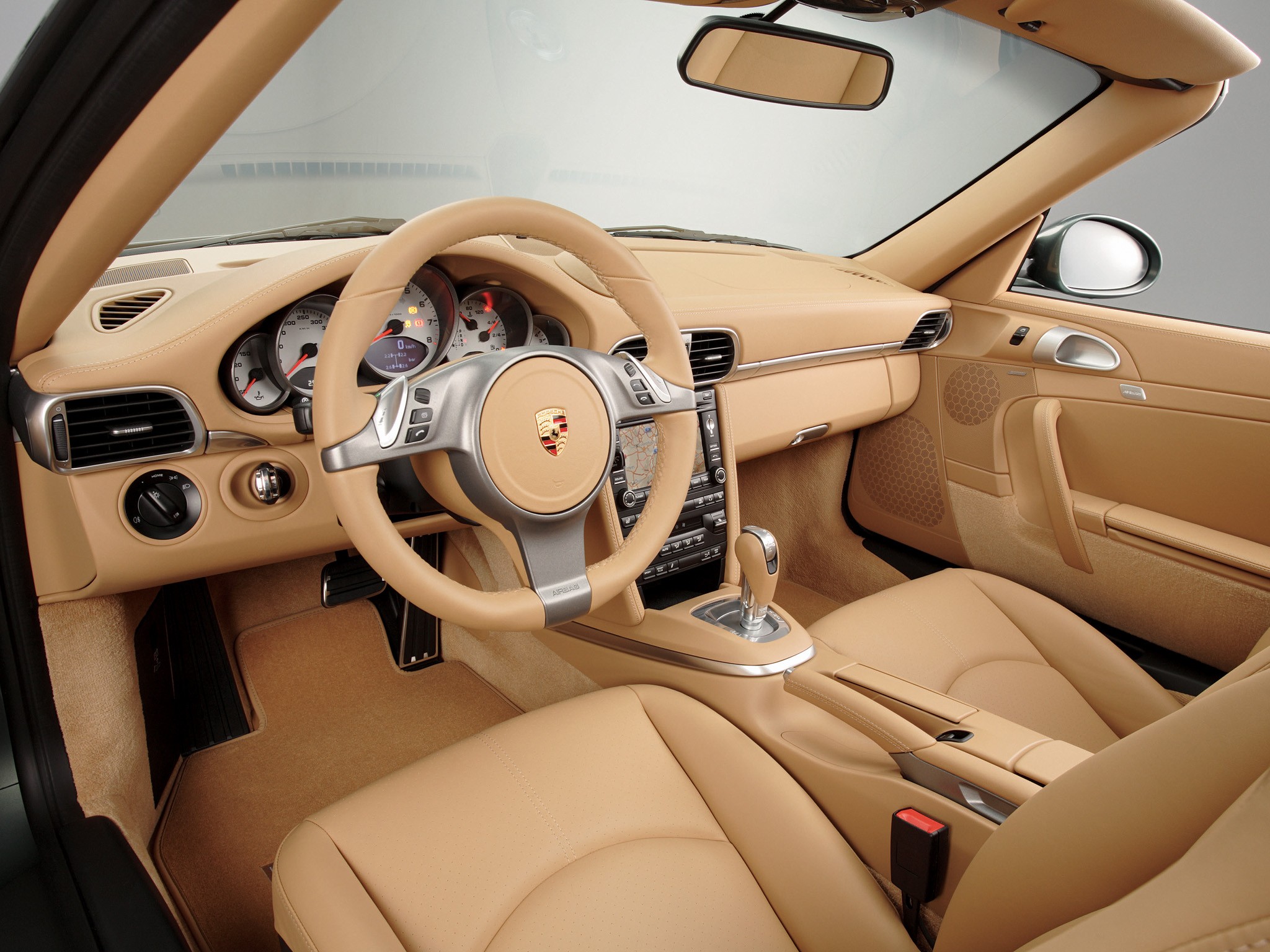(2009 – 2012) Porsche 911 Carrera S Cabriolet (997.2) – Ultimate Guide
Like the rest of the range the Carrera S Cabriolet got a new 997.2 generation update. Not much is new on the outside, but the design refresh did give it a revised front bumper and larger air intakes, as well as by new large mirrors and the bright strip of LEDs below the headlights that serve as daytime running lights.
Inside the car, there’s a new communication management system, PCM 3.0 which includes a new touchscreen feature, is standard on all 2009 and onward 911s. Along with this upgraded system, options such as a hard disk drive navigation system, XM radio with XM NavTraffic capability, Bluetooth connectivity, iPODport, USB port, and aux jack will be available. There are no changes to the sports convertible, the drop-top in the 997.2 Carrera S Cabriolet featuring the same power-roof, which could cover and uncover the car in 20 seconds.
Engine output in the 3.6-liter model has shot up 20 ponies to 345 hp, while the 3.8-liter engine in S-models has improved by 30 ticks to 385 hp. Each engine is slightly more compact (30 mm shorter top to bottom), with a lower center of gravity. Porsche also says that there’s less friction in these new flat sixes, a higher redline (7250 rpm) and 40 percent fewer components, thanks to greater integration. For example, the crank ladder and camshaft bridge units are now included in the block and head castings. An electronically controlled variable-volume oil pump delivers lubricant in response to demand, and is said to reduce parasitic losses by 3 hp—and improve fuel consumption by 2 percent, too.
The new generation 911 is available for the first time with the new Porsche-Doppelkupplung (PDK), Porsche’s double-clutch gearbox. The seven speed gearbox combines the driving comfort of an automatic transmission with the gearshift capacity of a sequential gearbox used in race cars. Since Porsche’s double-clutch also boasts an automatic gearshift function, it replaces the former Porsche Tiptronic S automatic transmission on both the Carrera and Carrera S. PDK improves acceleration while reducing fuel consumption over the previous generation of Tiptronic S equipped 911s through optimized and adaptive gearshifts.
The 997.2 Carrera S Cabriolet, equipped with the PDK transmission, can hit 60 mph in just 4.5 seconds which is 0.2 seconds faster than with a manual six-speed gearbox. Top speed for the 997.2 Carrera S Cab is 187 mph, the same as the coupe.
Pictures
Press Release
The very first sports car to bear the Porsche name was introduced to the world in June, 1948. Therefore, as the proud, independent Swabian automaker celebrates sixty years of sports car excellence, it is only fitting that it has a new Porsche 911 Carrera – for many the quintessential Porsche-to help mark the milestone.
This latest Porsche 911 Carrera Coupe and its higher-performance variant, the 911 Carrera S Coupe, are the most sophisticated, potent and environmentally friendly Porsche 911 Carrera models that Porsche has ever offered.
Despite their abundance of 21st century technologies, the 2009 911 Carrera Coupe and Carrera S Coupe clearly trace their engineering and aesthetic roots to the seminal Porsche. That original car evolved over fifteen years from the highly coveted 356 to the first 911 when, at the 1963 Frankfurt Motor Show, the ground-breaking 1964 911 Coupe debuted. As a testament to the genius of its design, after more than forty years of development and six generations of engineering improvements, the 911 Carreras still showcase a horizontally opposed, rear-mounted six-cylinder engine carried in a distinctive and instantly recognizable body.
Less Fuel In, More Power Out
Though the 2009 Porsche 911 Carrera Coupe and 911 Carrera S Coupe are each propelled by Porsche’s familiar horizontally opposed, six-cylinder “boxer” engine, and despite the fact that both engines carry the same displacement designation as their immediate predecessors, both are substantially different than in 2008 model year.
Most critically, both the 3.6-liter engine in the Carrera Coupe and the 3.8-liter in the Carrera S Coupe are now equipped with direct fuel injection. In addition, the engines are of a new, more robust construction than before, boasting a two-part crankcase for increased structural rigidity. Further, both engines benefit from higher compression ratios and improved breathing, compared with the previous versions.
The results are astounding and immediately rewarding to the driver. The 2009 911 Carrera Coupe develops 345 horsepower at 6500 rpm and 288 lb.-ft. of torque at 4400 rpm. That’s an output of 95.5 hp per liter and represents an increase of 20 hp and 15 lb.-ft. At the same time, fuel consumption is reduced by 6.4 percent over last year, when the cars are equipped with a manual gearbox. The all-new PDK transmission further improves fuel economy over the previous Tiptronic S, by a total of 12.5 percent.
This new engine propels the Carrera Coupe with a manual gearbox from a standing start to 60 mph (96 km/h) in 4.7 seconds and achieves a top speed of 179 mph (289 kmph) on the test track.
The blazingly quick Porsche double-clutch automatic transmission takes two-tenths of a second off that run, making the 0 to 60 mph (96 km/h) sprint in 4.5 seconds. The top speed is a track-proven 178 mph (287 kmph).
Yet, despite this exhilarating performance, the Carrera Coupe carries no gas-guzzler penalty. In addition, this engine is so environmentally friendly that the car is certified by the federal government as a Low Emissions Vehicle, category two (LEV-II).
In Porsche Parlance, “S” Means More
The 2009 Porsche 911 Carrera S Coupe, like its predecessor model, is powered by a larger, more potent version of the Porsche horizontally opposed six-cylinder than its non-S sibling. As with the 3.6-liter version in the Porsche 911 Carrera, the 3.8-liter engine benefits from less weight, a two-piece crankcase, improved intake and exhaust, and direct fuel injection. The fruits of these refinements are 385 horsepower at 6500 rpm and 310 lb.-ft. of torque at 4400 rpm. This is an increase of 30 hp and 15 lb.-ft. of torque while achieving a power output of 101.3 hp per liter, without the need for any form of supercharging.
With a boost in potency, the Porsche 911 Carrera S Coupe with manual gearbox runs to 60 mph (96 km/h) in only 4.5 seconds, on its way to a track-proven top speed of 188 mph (302 kmph).
The PDK driving-shifting automatic transmission shaves two-tenths of a second off the acceleration times of Porsche’s most skilled test drivers. The 0 to 60 mph (96 km/h) run takes only 4.3 seconds. Track-proven top speed for the Carrera S Coupe with PDK is 186 mph (300 kmph).
Despite its awesome performance the nearly 400-hp Carrera S Coupe carries no gasguzzler stigma. And the added power and torque do nothing to diminish the engine’s clean exhaust. Like the Carrera Coupe, the Porsche 911 Carrera S Coupe is certified as LEV-II.
It Starts With a Straight Shot
Both the 3.6-liter and 3.8-liter horizontally opposed, six-cylinder engines in the Porsche 911 Carrera Coupe and 911 Carrera S Coupe are substantially revamped from the similarly designated engines in last year’s model range.
The engines still consist of a light alloy crankcase and cylinder heads, and have four valves per cylinder actuated by dual overhead camshafts. Now, for the first time in a Porsche sports car, the engines boast a direct fuel injection system (DFI), which works in concert with Porsche’s VarioCam Plus valve lift and timing control.
By injecting fuel directly into the combustion chamber rather than in the intake port, DFI delivers myriad benefits. Since the fuel charge arrives closer to combustion than with port injection, throttle response is instantaneous, and the Porsche 911 Carrera driver feels a razor-like reaction to even the slightest movements of his right foot, whether accelerating or lifting from the throttle.
To take fullest advantage of the DFI’s attributes, Porsche’s engineers designed the combustion chamber and piston crown to maximize efficiency. Those refinements allowed the engineers to design both the 3.6-liter and 3.8-liter engines with a compression ratio of 12.5:1. This is up from 11.3:1 on the previous 3.6-liter and 11.8:1 of the former 3.8-liter. To ensure maximum efficiency and durability, the DFI injectors have been designed and manufactured to deal with working pressures of up to 1740 psi (120 bar) in the combustion chamber.
The fuel injector nozzle is between the two intake valves, spraying fuel directly into the incoming fresh air charge from both valves. This is clearly far more efficient than port injection which naturally leaves some unburned gasoline on the intake walls and valves. The incoming fuel charge further aids the combustion process by cooling the incoming air as it vaporizes, allowing more air to be drawn into the engine for a denser charge and permitting the higher compression ratios. Finally, the fuel and air are mixed more evenly and thoroughly when the fuel is injected directly into the air inside the combustion chamber.
DFI also reduces emissions since the engineers were able to reshape the piston crown to completely direct the fuel charge at the spark plug for thorough combustion. During start-up, the engine benefits from high-pressure stratification of the injected fuel. Then to quickly light off the catalysts, the DFI heats the exhaust rapidly through multiple injection. To increase the temperature of the exhaust gas to an even higher level, ignition timing is very late, further minimizing start-up emissions.
The system also employs multiple fuel injection during periods of combined high loads and engine speeds up to about 3500 rpm-as when the driver floors the throttle at slower speeds. During the multiple injection phases, the injectors split the fuel charge into several successive bursts during the piston’s intake stroke. Otherwise, the fuel is injected in one phase during each intake stroke.
As with their predecessors, the new 3.6-liter and 3.8-liter engines are equipped with Porsche’s VarioCam Plus intake valve timing and lift system. Porsche’s engineers have refined the elements and operation of the VarioCam Plus to optimize the benefits of the DFI. The engineers re-aligned the profiles of both the intake and the exhaust camshafts. The diameter of the intake tappets has been reduced from 33 to 29.5 mm (1.30 – 1.15 in.) and the exhaust valve tappets are down from 33 to 24.2 mm (1.30 – 0.94 in.). This reduction in mass allowed the engineers to safely raise the engines’ redlines, from the previous 7300 rpm to 7500 rpm.
Two, Two Camshafts in One
As with all Porsche engines, VarioCam Plus in the Porsche 911 Carrera and Carrera S Coupes adjusts intake valve lift and timing based on engine speed and load, and is under the umbrella of the engine’s main electronic controller. Though the VarioCam Plus operates far too quickly for the driver to be aware of it, the results are obvious. The effect is that of an engine with two different intake camshaft profiles, one set up for smooth and efficient around-town driving, the other a high-performance camshaft designed for high-speed. Each of these two designs usually precludes the other and most cars have a compromise of the two. Porsche’s VarioCam Plus removes the compromise and the driver benefits from the best of both driving worlds.
Valve timing is controlled via a vane cell adjuster which continuously varies the two intake camshafts positions relative to crankshaft. Valve lift is varied by a system utilizing two cup tappets, one resting in the other. These tappets are actuated by separate cam lobes of differing size. The engine control module directs oil pressure to the appropriate tappet based on engine speed and load parameters. When nonpressurized, the tappet moves under the camshaft lobe, but exerts no pressure on the valve, in effect free wheeling.
More Efficiency through Better Breathing
The Porsche VarioCam Plus in the new engines has also been refined to take full advantage of their redesigned, freer-flowing intake manifolds. The new intakes boast a dual chamber design, in place of last year’s single chamber unit. The intakes have two openings and separate intake funnels in the rear engine cover. These funnels feed air to separate, round air filters. Besides greatly reducing flow resistance, the dual filters provide a side benefit to owners: The replacement interval has been increased from 37,000 to 56,000 miles.
As with the previous model, the upper section of the 3.8-liter engine’s filter features actively switchable resonance volume. Additional volume is activated as a function of engine speed, with temperature compensation being provided by a vacuum-controlled butterfly, improving the engine’s acoustics.
The new intake manifolds themselves are made of a special synthetic material. They incorporate a resonance pipe integral with the air-distribution pipe between left and right intake runners, as well as additional resonance chambers. The larger engine in the Porsche 911 Carrera S Coupe also has a switchable resonance butterfly, which adjusts the oscillation of the intake charge to maximize torque at lower engine speeds. At full load between 2600 and 5100 rpm, the resonance butterfly is closed; at lower and higher speeds it is open.
The exhaust manifolds are also new. The lengths of the individual exhaust runners have been equalized and optimized for smoothness and efficiency. The catalytic converters are directly behind the right- and left-hand manifolds, rather than being mounted crosswise behind the engine. Thanks to the engines’ DFI, there is no need to inject secondary air into the exhaust stream to complete combustion, as in the past.
The exhaust systems of both engines are the same, save their distinctive outlets. As in the past, the 3.6-liter powered Porsche 911 Carrera Coupe has two individual oval tailpipes while the 911 Carrera S Coupe is distinguished by its dual round brushed stainlesssteel tailpipes.
Stronger, and Lighter, Too
While gaining sophistication, technology and power, the new horizontally opposed, six-cylinder engines in the 2009 Porsche 911 Carrera and Carrera S Coupes lost weight.
Both engines are 13.2 pounds (6 kg) lighter than their predecessors. Among the critical changes to the basic engine design is a new two-piece crankcase instead of the previous four-piece unit. The new crankcase has integral crankshaft bearings, compared with the former separate crankshaft bearing housing. In addition to reducing complexity, Porsche’s engineers enhanced the thermal and mechanical stability of the engine. They also went from an open-deck to closed-deck layout. With the closed-deck configuration, the tops of the cylinder liners are now connected with the housing by a top plate which incorporates the coolant sleeves. This design increases stability and durability while helping reduce oil consumption and friction.
Further weight and complexity are saved through the elimination of the intermediate shaft needed to drive the timing chains on the old engines. Thanks to new, highly resistant timing chains, that shaft is not needed. Porsche’s engineers also developed new one-piece cylinder heads which incorporate the camshaft bearings and the guide cylinders for the hydraulic cup tappets.
Leaving no stone unturned in their quest for maximum efficiency, Porsche’s engine designers developed a new engine lubricating oil system that ensures thorough lubrication regardless of driving conditions while minimizing operating losses for improved fuel economy.
Given the Porsche 911 Carrera Coupe and Carrera S Coupe are designed to be driven quickly and enthusiastically, every element of the cars must withstand extended periods of high levels of lateral acceleration. Drawing from decades of racing success, Porsche’s engineers ensured the cars’ engines would always be adequately lubricated, even under the most extreme driving conditions. The new engines use Porsche’s proven dry sump system, with four intake and one electronically controlled, pressure oil pump operating on demand. The engine’s electronic management system adjusts the supply of oil by means of a hydraulically activated, axially moved gear in the pressure pump. As the gear is moved, its mesh section width is changed, varying the volume of oil moved. The pump runs on a chain-driven shaft spun by the crankshaft. The result is optimum lubrication with minimal energy consumption.
In addition, two suction pumps extract oil from each of the two cylinder heads and feed it to the oil sump where a new baffle plate largely separates the crankcase and the sump, reducing splash losses in the crankcase and minimizing oil foaming in the sump.
The integrated dry-sump system is so precise at monitoring oil levels that the engines have no engine oil dipstick. Instead, an electronic monitor measures the oil level and displays the result on the instrument cluster.
Keeping It Cool
Engine cooling for both the 3.6- and 3.8-liter engines has also been improved. The coolant passages have been upgraded over the previous engines and the engineers increased cooling around the exhaust valve seat rings, expediting heat dissipation in the cylinder heads. The engines also boast a new externally mounted coolant pump. The new pump flows approximately 20 percent more coolant than the old. These modifications along with the optimized flow of cooling air at the front of the car allowed the designers and engineers to eliminate the center radiator found on the previous models.
Different Size That’s the Same
Finally, the various internal refinements to both the 3.6-liter and 3.8-liter engines result in slight changes to their displacements.
The 3.6-liter engine in the 2009 Carrera Coupe now has a 3.21 inch (81.5 mm) stroke, up by 1.3 mm over last year. Bore has been increased by 1.04 mm, and is now 3.82 inches (97 mm). The Porsche 911 Carrera S Coupe’s 3.8-liter engine has a 3.05 inch (77.5 mm) stroke, down from the predecessor’s 3.226 inches (82.8 mm). Bore has been increased by 3 mm to 4.02 inches (102 mm).
The results of these changes are that the 3.6-liter has an actual displacement of 3614 cc, or 18 cc more than before. The 3.8-liter actually sheds 24 cc and is now exactly 3800 cc.
Getting the Power Out
As before, both the Porsche 911 Carrera Coupe and Carrera S Coupe come equipped with a six-speed manual gearbox as standard. Commensurate with the increase in power over last year’s models, the transmissions in both cars have been strengthened and refined.
Steel rather than brass synchronizing rings as well as thick shafts and wide gears provide strength, yet the transmission’s weight is kept down by using extra-thin aluminum in the oil chamber walls. The transmission’s internal architecture minimizes splash effect and flow losses, increasing the efficiency.
The gearbox uses wear-resistant carbon-coated synchromesh rings on first, second and third gears. In addition, first and second boast triple synchronizers. Third gear has double synchronizer rings and fourth through sixth gears uses a single ring. Taking advantage of the engines’ increased output, the engineers altered Third gear, making it about 3 percent taller than before. This change improves around town fuel economy with no impact on performance or derivability.
These internal details mean the driver can shift more quickly and smoothly, since less force is needed and the linkage has shorter travel during gear changes.
In addition, the wear-compensating clutch which was formerly only found on the Carrera S, is now standard on the 3.6-liter model. As the friction face of the clutch wears, an adjustment ring in the pressure plate automatically compensates for the wear.
All 2009 911 Carrera models, regardless of transmission, also boast Start-Off Assistant as standard. This feature allows the driver to get moving again smoothly without rolling on a hill when starting from a stop. When the driver stops on an incline and leaves the transmission in gear, the Start-Off Assistant maintains brake pressure for about two seconds after the driver lifts his foot from the brake pedal. Then the system incrementally reduces brake pressure. As soon as the driver accelerates, brake pressure is fully released.
Multiple Clutches and Seven Speeds
For 2009, both the Porsche 911 Carrera and Carrera S Coupes can be equipped with the innovative and blazingly fast Porsche PDK transmission. The seven-speed, driver-shiftable automatic replaces the five-speed Tiptronic S as the optionally available transmission.
Though it was developed in the 1980s for the all-conquering Porsche 962 Group C racecar, thanks to recent advances in electronic control technology, this is the first time that the PDK is available in a street-faring sports car.
The new PDK (which comes from the German Porsche-Doppelkupplungsgetriebe or Porsche double-clutch transmission), like the Tiptronic S, allows the driver to shift up and down using either steering-wheel mounted paddles or the console-mounted lever. Or, if he’d rather, the driver can simply leave the PDK in automatic mode and allow it to operate totally on its own.
Two, Two, Two Gearboxes in One
Put extremely simply, the PDK is two manual gearboxes combined into one unit. At its crux, the PDK has a sophisticated electronically controlled valve body overseeing the operation of two separate multiplate wet-clutch packs, each with its own gearset. One clutch activates first, third, fifth, seventh and reverse, the other acts on second, fourth and sixth.
Only one of the clutch packs is engaged at any given moment. As one disengages, the other simultaneously engages. Since each gear is preselected and already in mesh when its clutch pack engages, the shift is completed instantly and without any loss of power. Like the clutch packs, the gears’ shift forks are electro-hydraulically operated. This all adds up to gearchanges that occur in milliseconds, faster – and smoother even under full load – than can be made by even the most adept driver.
The PDK shifts gears up to 60 percent faster than an automatic transmission, with no interruption in power flow. The Porsche 911 Carrera Coupe and Carrera S Coupe with the double-clutch transmission accelerate from 0 to 60 mph (96 km/h) eight tenths of a second more quickly than their predecessors with Tiptronic S, while using up to12.8 percent less gasoline.
Despite the fact that the new PDK double-clutch has two more gears than the previous Tiptronic S, the new unit is compact and weighs 22 pounds (10 kg) less than the Tiptronic S. The two clutch units are interconnected, and each clutch pack consists of five oil-bathed friction discs. The two radial, multiple-plate packages forming the double clutch unit are engaged and disengaged independently of one another by the control valve. Porsche’s engineers opted to use the compact wet clutches for their thermal resistance, service life and their superiority to a dry double clutch in handling the significant torque of the new engines.
Follow the Numbers
In manual mode, under load, the PDK upshifts sequentially, alternating between odd and even numbered gearsets. During downshifts, however, the PDK can skip gears, even going from Seventh to Second. In downshifts within the same gearset, intermediate gears in the other unit are engaged briefly. For example, if the PDK downshifts from Sixth to Fourth, Fifth gear is activated temporarily as Fourth gear is selected and the ECU synchronizes engine and transmission speeds.
Do It Yourself
Drivers can either leave the PDK in fully automatic mode, or they may up- or downshift for themselves. The gearshifts with the PDK double-clutch transmission can be made the same way they were with the previous Tiptronic S, via console-mounted shift lever or steering wheel-mounted paddles. When the shift lever is placed in the manual-shift mode-done by pressing the locking button on the lever handle – tipping it forward upshifts, while moving it to the rear downshifts.
Porsche engineers developed a new standard steering wheel to complement the PDK. The new wheel is a three-spoke design and is 14.6 inches (370 mm) in diameter. The steering wheel features two ergonomic paddles. Pressing either paddle from the front upshifts, pressing from behind downshifts. The PDK can also be fit with either the optional sports steering wheel or the Porsche multifunction wheel. As a further option, the steering wheels may be heated as well.
Wait, There’s Still More Performance Available
For those enthusiast drivers who want even more direct control of the PDK doubleclutch transmission, Porsche’s engineers have configured the optional Sports Chrono Package Plus to work with it.
Pressing the Sport or Sport Plus button on the center console allows the driver to select his desired gear directly. The shift points are adjusted infinitely as a function of the driver’s style and the button pressed. An added feature is an aggressive downshifting program whenever the driver hits the gas pedal quickly, even without a kick-down shift.
The available Sport program provides enhanced driving of dynamics by preventing an automatic upshift when the driver lifts off the throttle quickly, as when entering a turn.
The transmission won’t upshift in curves if the car’s lateral acceleration and road speed inform the ECU that the driver is driving aggressively. Automatic and quick downshifts under braking are based on the vehicle’s road speed and rate of deceleration. Finally, the program alters the shift points to compensate for elevation above sea level.
The driver always has the ability to shift gears directly, regardless of the PDK’s program mode. While in the fully automatic mode, the manual gear selections made via the steering-wheel paddles remain in effect for about eight seconds, depending on the vehicle’s momentum and lateral acceleration.
Porsche’s Sports Chrono Package Plus incorporates the company’s Launch Control and a special gearshift function for extremely dynamic driving. Launch Control delivers optimum acceleration, regardless of conditions and is activated by pressing the Sports Plus button in the center console. For race-like starts, the driver holds down the brake pedal with his left foot while pressing the accelerator pedal with his right, revving the engine to about 6500 rpm. He then releases the brake, and PDK ensures minimal wheelspin with maximum torque.
The Sports Chrono Package Plus with PDK also offers a gearshift strategy for extreme performance with shift points optimized for the track. Activated by the Sports Plus button, the PDK switches to the fastest possible reaction and gearshift times, twice as fast as on the Tiptronic S. When shifting up under full load, the engine is revved up to maximum speed with a brief overboost of power. And to optimize performance when downshifting, the transmission automatically applies extra gas in between shifts.
Limiting Slip at the Rear Wheels
Both the Porsche 911 Carrera and Carrera S Coupes offer optional limited-slip differentials. This feature is available with both manual gearbox and PDK double-clutch transmission. The limited-slip is mechanical and provides 22 percent lock under power and 27 percent in overrun. The limited-slip works in concert with the standard Porsche Stability Management (PSM) to further improve traction on varied surfaces and when driving enthusiastically, especially around curves.
Both Carrera Coupes have a final drive ratio of 3.44:1, with or without the optional limited-slip differential.
Stopping What Goes Fast
Inherent in the Porsche philosophy is that every Porsche must have braking power at least commensurate with its acceleration and top speed capabilities. Therefore, all are equipped with cross-drilled, internally vented four-wheel disc antilock brakes. And as the Porsche 911 Carrera and Carrera S Coupes have more power and speed than their immediate predecessors, they have more braking ability as well.
All four rotors on both Carrera and Carrera S are now 12.99 inches (330 mm) in diameter. While these are unchanged for the Carrera S, for the 2009 Carrera, this represents an increase of almost half an inch, or 3.75 percent, for the front brakes and 1.2 inches, or 10.4 percent, for the rear brakes, over last year. The front rotors are 1.34 inches (34 mm) thick; the rears are 1.1 inches (28 mm) thick.
Both cars also have four- and monobloc piston fixed calipers clamping the rotors. The Carrera Coupe has black calipers, the Carrera S red ones. These calipers are borrowed from the 911 Turbo and are reinforced aluminum. Porsche’s engineers increased caliper strength and stiffness by adding crossbars to the piston-bearing side units.
Greater Stopping Power Available
Driver’s desiring even greater stopping performance than Porsche’s already wellrenowned braking can specify Porsche Ceramic Composite Brakes (PCCB), which are available as an option on both Porsche 911 Carrera Coupes. Cars so equipped are instantly recognizable by their yellow brake calipers.
Developed for the extreme use of motorsports, PCCB replaces the standard metal brake rotors with 13.78 inch (350 mm) ceramic discs. Besides delivering otherwise unobtainable levels of consistently superb braking performance under repeated heavy use, the ceramic rotors weigh approximately 50 percent less than the iron ones. PCCB reduces the car’s unsprung mass by 34.4 pounds (15.6 kg).
Chillin’
To help ensure superb braking even during long periods of hard use, the 2009 Carrera Coupes have new, larger brake-air spoilers on the front suspension control arms to improve cooling and active brake venting from the 911 Turbo, with additional openings in the underbody. Cooling air is fed to the rear brakes via an airflow duct as well as a newly developed brake air spoiler, which allows the rear brakes to handle a greater share of the braking load than before. This results in greater reliability and shorter stopping distances.
Fill ’em up
For 2009, the rear-wheel drive Porsche 911 Carrera and Carrera S Coupes receive Porsche’s Brake System Pre-Filling and Brake Assistant found on the all-wheeldrive models.
Pre-filling the brake system shortens stopping distance and increases reaction time in emergencies. If the driver suddenly releases the accelerator pedal, the system assumes he is about to hit the brake pedal. In those instances, brake fluid pressure is automatically and instantly built up, placing the brake pads lightly against the rotors before he actually steps on the brake pedal.
Similarly, Brake Assistant shortens stopping distances in emergency by increasing brake assist hydraulically, adding to the vacuum brake boost. If the driver’s foot on the brake pedal moves faster and with more force than predetermined levels, Brake Assistant automatically provides maximum braking force.
For those skilled enthusiast drivers who want to deactivate Brake Assistant, it may be switched off along with the standard Porsche Stability Management by hitting the “PSM Off” switch, or by hitting the Sports button on cars equipped with the optional Sports Chrono Package Plus.
Reliable Vacuum Assist
As with the brake systems on many cars, the Carrera Coupe and Carrera S Coupe have vacuum-assisted braking. However, unlike most, the Porsches do not rely on intake-manifold vacuum for that assist. Carrera Coupe and Carrera S Coupe have a mechanical vacuum pump driven by the right-hand cylinder bank’s exhaust camshaft. The vacuum pump ensures a constant and reliable source of braking assist, regardless of ambient air pressure or steady open-throttle driving.
No Heavy Spare
For 2009, the Porsche 911 Carrera Coupe rides on standard 18-inch light-alloy wheels of a new, twin-blade, five-spoke design. The front wheels are 8 inches wide, the rears are 10.5 inches wide.
The Carrera S Coupe boasts 19-inch diameter light-alloy wheels. The wheels are a new distinctive design, with five sets of parallel dual spokes. To reduce unsprung weight and improve handling, the 19-inch wheels are made in flow-forming technology, which delivers very thin but very strong walls. The front wheels are 8- inches wide, like the Carrera Coupe; however, the rear wheels are 11 inches in width.
For 2009, ride, handling, fuel economy, and tire life of the Porsche 911 Carrera models are all improved, compared with the predecessors, compliments of newly compounded tires. The tires are all Z-rated radials, with the Carrera Coupe riding on 235/40- aspect in front and 265/40 in the rear. Given its higher performance potential, the Carrera S sits on 235/35 fronts and monstrous 295/30 rears.
The larger 19-inch wheels and tires of the Carrera S Coupe are optional on the Carrera Coupe. Also available as options are the new 19-inch Turbo wheels.
To help reduce vehicle weight by 22 pounds (10 kg) and save space, the Carrera and Carrera S Coupes carry no spare tire, jack, or tire-changing tools. Instead the cars are equipped with a small electric air compressor and tire sealant, allowing the emergency repair of a small puncture. This gives the driver the safe opportunity to drive at speeds up to 50 mph (80 km/h) to have the tire properly repaired or replaced.
Keeping Up the Pressure
To ensure optimum safety, fuel economy and performance, Porsche engineers provide Carrera Coupe and Carrera S Coupe drivers with a safeguard against driving on a damaged or an underinflated tire. Both cars come with Porsche’s Tire Pressure Control system (TPC). This system uses sensors at each wheel to constantly monitor inflation pressures. The system offers the driver two levels of warning, should it detect a problem.
If any tire shows a pressure drop of more than 2.9 psi but less than 5.8 psi from specifications, a text message in white lettering shows in the tachometer. This warning appears for 10 seconds each time the car is started. If pressure drops more than 5.8 psi, or if inflation pressure drops at a rate of 2.9 psi or more per minute, the warning becomes more urgent and is displayed in red text. This warning appears as soon as the respective values are exceeded, whether the vehicle is stationary or moving.
The system has been given upgraded wheel sensors for 2009, which use a new communication technology and larger batteries.
Now utilizing Tripper Logic, the sensors transmit their signals only whenever requested to do so by the control unit, except in the event of a rapid drop in pressure, which triggers a continuous signal. To efficiently receive signals from the wheel transmitters, the new generation of TPC now uses a central receiver aerial beneath the floor of the car, replacing the previously used aerials in each wheel arch. The system can now continue monitoring tire pressures in the other wheels even if some of the control units fail. With the new system, battery service life goes from seven to ten years.
Sporty Handling = Accident Avoidance
Knowing full well that all vehicles are safest by avoiding an accident in the first place, Porsche’s engineers understand that their cars’ awesome dynamic abilities are as much of a safety feature as a performance attribute.
To ensure both dynamic safety and an exhilarating driving experience, Porsche’s engineers have continued to refine and enhance their cars’ suspensions. Building upon a wide stance, both the Porsche 911 Carrera and Carrera S Coupes sit on a large, secure footprint. Both cars have a 58.6 inch (1486 mm) front track. In back, the Carrera has a 60.4 inch (1534 mm) track. With its larger wheels and tires, the Carrera S has a rear track of 59.7 inches (1516 mm). Porsche’s engineers then specified a lightweight and technologically advanced suspension system and a low center of gravity for optimum agility and driver confidence assuring stability.
The Carrera Coupe and Carrera S Coupe boast Porsche’s proven front suspension. This consists of a McPherson design, optimized by Porsche; spring strut axles with separately mounted longitudinal and track control arms; conical stump springs with an inner damper; and twin-sleeve gas-pressurized dampers. The dampers on the Carrera S feature active control, as they are an integral part of that car’s standard Porsche Active Suspension Management (PASM).
In the rear, the Carrera and Carrera S Coupes have the maker’s five-arm, springstrut suspension with longitudinal and track control arms. The rear coil springs have co-axial, single-sleeve gas-pressure inner dampers. As in front, the rear dampers of the Carrera S boast active control.
The standard suspension of the Porsche 911 Carrera Coupe for 2009 features an additional front and rear stop springs. These springs have an outbound spring motion on the wheels, enhancing ride comfort.
Better Living through PASM
As noted, the Carrera S Coupe comes standard with the most recent version of Porsche Active Suspension Management (PASM). This system is optional on the Carrera Coupe. For the 2009 911 Carrera models, PASM suspension has refined springs and antiroll bars for even greater comfort. Porsche’s engineers were able to accomplish this by fine-tuning the PASM control function, delivering a smoother ride on bad roads in both the Normal and Sport modes with no degradation in handling.
This electronically controlled suspension allows the driver to select either a Normal or Sport setting, depending on the driving situation and conditions. Besides allowing the choice of choice setups, PASM also lowers the car’s ride height by about 0.4 inch (10 mm).
At the core of PASM are continuously adjustable dampers, a front and rear accelerometer, and a dedicated electronic control unit. The PASM controller receives data about the vertical movements of the car’s body, as well as steering angle, vehicle speed, brake pressure, and engine torque.
The control unit then alters oil flow within the dampers to constantly provide the optimum firmness for the conditions and driver’s desire. The system’s active dampers have a similar structure as standard shock absorbers but incorporate an electronically controlled internal bypass valve that increases or reduces oil flow as needed.
More than merely a two-setting suspension, PASM automatically adjusts to the driver’s style. If left in Normal mode, the PASM will gradually increase the suspension’s firmness if the car is driven with greater enthusiasm, generating higher dynamic forces.
Rapid and sudden steering movements indicate to the control unit an immediate need to increase damper forces on both axles to reduce swaying or rocking.
By monitoring vertical motions of the body, the system can firm the dampers in Normal mode as reaction to a rough road, minimizing rocking. However, in Sport mode, the same motions alert the controller to reduce the damping forces to ensure that the wheels remain in contact with the road and increase ride comfort.
When the driver steps on the brakes, PASM firms the dampers to reduce body dive and, as the braking sequence continues, adjusts to softer damping with different forces front and rear, to ensure solid tire-to-surface contact even on broken pavement or rough roads, and to minimize stopping distance.
PASM also controls body squat during full-throttle acceleration. As the driver may briefly lift off from the throttle during gear shifts, PASM instantly adjusts firmness at front and rear axles to compensate for the brief change in loads. In Normal mode, PASM increases damping to prevent excess squat. In Sport mode, the damping is softened to improve traction.
New Sports Suspension
Porsche engineers have also configured a special new variant of PASM for the 2009 Porsche 911 Carrera and Carrera S Coupes. Intended for the serious and skilled enthusiast driver, the setup replaces the former sports suspension.
Like the previous passive sports suspension, the new, PASM sports suspension gives the car an even firmer and tauter ride, at the same time lowering the entire vehicle by 0.79 inches (20 mm). This new suspension improves both handling performance and comfort, compared with the passive system. The active sports suspension is available together with the mechanical limited-slip differential, and either the manual gearbox or PDK.
Stability is standard
Both the Carrera Coupe and Carrera S Coupe are equipped with enhanced Porsche Stability Management (PSM) as standard equipment. For the newest models, PSM now adds both Brake Pre-Filling and Brake Assistant, previously reserved for Porsche’s all-wheel drive vehicles.
PSM is a computerized system that relies on data from an assortment of sensors to help maintain the car’s intended path as the driver pushes it to the edges of its dynamic limits. By comparing speed of the individual wheels, vehicle speed and engine speed, PSM can determine that the car may be beginning to slip sideways or that a tire is losing traction and beginning to spin.
To rein the car back under the driver’s control, PSM applies individual brake force to a slipping wheel. If more drastic measures are required, PSM works with the engine control module to reduce engine power briefly. PSM is programmed to intervene less quickly when the car is moving below 45 mph (70 kmph) to allow the driver more latitude.
PSM uses advanced antilock brake sensors that take their readings from multipole seats fitted directly on the wheel bearings. These signals allow more precise processing and control than other types. Instead of conventional shaft valves, linear solenoid valves adjust brake pressure with nearly infinite precision. To provide pressure more quickly, an advanced hydraulic pump is used, thus eliminating the need for a pre-charging pump and its connections.
Besides helping ensure stability, PSM boasts new functions. Critical among them is Brake Pre-Filling which can shorten stopping distances in an emergency. Whenever the driver lifts off the gas pedal abruptly, the system instantly pumps brake fluid from the hydraulic PSM control unit to the brake calipers, placing the pads lightly against the rotors before the driver’s foot actually hits the brake pedal.
The refined PSM also now has Brake Assistant which helps drivers apply full braking force when needed. If the driver hits the brake pedal hard, but not with full force, PSM instructs the hydraulic pump to apply the rest, right up to the ABS threshold.
Like all Porsche dynamic safety-enhancement systems, the enhanced PSM does not interfere with a skilled enthusiast’s pleasure. If the driver doesn’t increase his pressure on the brake pedal past a certain point, the additional pressure built up by the system is reduced. Critically, the pressure booster does not always cut in.
And true to Porsche’s philosophy that the driver should always be in command of the vehicle, PSM can be switched off by the driver, unlike some other systems. When deactivated, the enhanced PSM remains off until the driver firmly hits the brake pedal, reaching the ABS threshold on at least one front wheel. This allows the skilled enthusiast driver more dynamic freedom. As with other Porsche performanceenchancing technologies, PSM is non-intrusive, never abruptly wrestling control of the car from the driver.
Variable-Ratio Steering
The Porsche 911 Carrera and Carrera S Coupes come with standard variable-ratio rack-andpinion steering. This both increases agility and stability at higher speed maneuvers and reduces steering effort at slow speeds.
When the steering wheel is turned within 30 degrees of center, the ratio is to provide a smooth and calm driving experience, even on rough surfaces. However, when the steering wheel angle exceeds 30 degrees, the ratio become more direct, reducing lock-to-lock from 2.98 to 2.62 turns. This gives the driver better control both on winding roads and in slow-speed parking maneuvers.
In addition to the variable ratio technology, the Porsche 911 Carrera Coupes have steering columns that tilt and telescope. The wheel can be adjusted by 1.57 inches (40 mm) in height and reach.
Incorporated in the steering system is an electric steering wheel lock as part of the car’s antitheft immobilizer.
Looks That Count
The uniquely familiar shape of six generations of Porsche 911 Carrera Coupes has defined the face of the sports-car manufacturer for generations of admirers. To ensure that the newest models continue that trend, Porsche’s designers have subtly refined the appearance of the 2009 models, giving the cars a look that is both evolutionary and instantly recognizable as a Porsche 911.
As always, improved function as at the root of changes made by Porsche’s designers. Critical among them are the new front air intakes which are larger than before to increase the flow of cooling air for the enhanced drivetrains and brakes.
These air intlets also highlight the new front lighting units which sit above the front air intakes. These horizontal lighting components have glass covers (with cleaners) and each hold six light-emitting diodes for the daytime driving lights. These units also cluster the positioning lights as well as the directional signals. The L.E.D. technology is also now used for the brake lights and taillamps.
Let There Be Lots of Light
For 2009, both the Porsche 911 Carrera and Carrera S Coupes come standard with BIXENON ™ headlights. These bulbs provide more than twice the illumination of halogen bulbs.
As an option, both cars may be equipped with dynamic bending headlights. Thanks to information from sensors which monitor steering wheel angle, vehicle speed and lateral acceleration, the BI-XENON headlights swivel to mimic the movement of the front wheels. The dynamic bending lights are activated as of a speed of 3 mph (5 km/h).
The maximum turning angle of the inner headlight in a bend is 15 degrees, the maximum turning angle of the outer headlight 7 degrees. Through these different turning angles the road ahead is illuminated by the widest possible unbroken swath of light. The dynamic bending lights operate with both low- and high-beams.
Classic Profile
The cars’ profiles are highlighted by the new larger outside mirrors and by the newly designed wheels. The Porsche 911 Carrera’s 18 inch alloy wheels have by five double spokes which are arranged so the each pair of spokes opens outward at the rim. The Carrera S has larger, 19 inch wheels which have five pairs of parallel spokes.
The true Porsche aficionado will also spot the larger outside mirrors, which despite their larger surfaces have a similar overall look as before. The larger mirrors do not detract from the overall excellent aerodynamics. An easily over-looked but significant detail is a water gutter extending above the edge of the mirror housing which reduces dirt and water accumulation on the mirrors.
Looking Back
At the rear, the new exhaust pipes are integrated in the rear body panel. The Porsche 911 Carrera has individual oval tailpipes; the Carrera S shows double round tailpipes. Black trim at the bottom of the rear apron disguises the distance between the tailpipes and the rear panel, at the same time giving the back end more of a sporty appearance.
All the rear lights, save the reversing lamp, boast L.E.D. technology. The single-piece rear light clusters each house the directionals, rear fog light, the reversing light, the brakelamp, positioning light, and the reflector as one unit. Each cluster contains 60 diodes. Only the reversing light utilizes a bulb.
The light-emitting diodes react more quickly than standard bulbs: While the response time of a conventional incandescent bulb is approximately 100 milliseconds, lightemitting diodes have a response time of only about 0.1 milliseconds. The L.E.D. lights also offer more luminosity and longer life than standard bulbs. The light units themselves are tapered a more distinctly to the outside than before, merging smoothly into the rear of the car. Red and silver-transparent lens covers add panache to the look.
Moving Air Over, Around and Through the Metal
When developing the new Carrera models, Porsche’s engineers and designers strove to guarantee a more-than sufficient flow of cooling air, regardless of ambient temperatures and operating conditions. The fruits of their labors are two sports coupes, each with a coefficient of drag of only 0.29.
An important factor contributing to this superior aerodynamic quality is the full underbody cover interrupted only by a few cooling air intakes for the brakes and transmission. Careful shaping of spoilers on the suspension components work with the air ducts to keep the brakes cool.
The new, larger air scoops at the front increase the drivetrain cooling by 20 percent over the previous versions. With the center intake guiding air to the two outer radiators, there is no longer any need for a center cooler for the PDK transmission as was needed on previous models with the Tiptronic S.
Resistance is Foolish
Porsche’s aerodynamicists worked with both body designers and suspension engineers, leaving no stone unturned in the quest for efficient airflow. To ensure low resistance and maximum stability, airflow over the body is carefully directed. Such details as the rear windshield wiper mounted directly to the window glass rather than to the bodywork, and the refined double-arm mounting of the outside rearview mirrors are based in good aerodynamics.
Despite the fact that the outside mirrors have larger reflecting surfaces than earlier models, their design keeps the side windows clean and reduces turbulence. The mirrors even help guide moving air around the car toward the rear spoiler. The spoiler itself automatically deploys at 75 mph (120 km/h) to enhance stability at higher speeds. As vehicle speed drops below 50 mph (80 km/h), the spoiler is not needed and so to reduce unwanted drag, it automatically retracts.
Less Lift, More Grip
Porsche’s aerodynamic engineers understand that airflow beneath the car is as critical as the air moving over it. Therefore they imbued the Porsche 911 Carrera Coupe and Carrera S Coupe with the high-speed stability that affords the driver confidence by carefully managing the underbody air movement. Thanks to the body’s aerodynamic details, the Coupe has a miniscule rear coefficient of lift of 0.02, and a front Cl of 0.05.
The Coupe’s underbody is almost entirely encased. When equipped with a manual gearbox, the underbody carries six polypropylene sheets.
The flow of engine-cooling air is directed out of the radiators and into the wheel arches rather than under the front tires. This helps with brake cooling and reduces lift. Stability is further enhanced by transitional zones beneath the front of the car that create a low-pressure area near the front axle.
Cooling Air
Special ram-air flaps around the engine fan boost cooling airflow at high speeds. At low speeds, the flaps remain closed and air is drawn only through the radiator; at around 45 mph (70 kmph), the flaps open under ram pressure. Special air ducts on the underbody direct cooling airflow to the brake discs, transmission, and differential.
Wheel well spoilers reduce drag by guiding air around the wheels. Optimized brake air spoilers and pivot bearings ensure effective air around the rotors, reducing disc temperatures.
What’s Inside Counts, Too
The luxurious passenger cabins of the 2009 911 Carrera and 911 Carrera S Coupes benefit from minor, but important refinements over their immediate predecessors.
Prime among these is a redesigned center console which houses the enhanced and enlarged Porsche Communication Management (PCM) system and the availability of ventilated front seats. The audio systems have been upgraded and the on-board telephone features Bluetooth connectivity and available voice command. In addition, the on-board computer offers additional functions, including the ability to check the car’s service intervals.
An Era of Communication
The crux of many of these convenience enhancements is the revamped PCM. The PCM is at the heart of all audio and communication functions. For the 2009 Porsche 911 Carrera models, the PCM features a new, larger monitor with touchscreen controls. By incorporating its controls into the touchscreen and eliminating the previous version’s keyboard, Porsche’s engineers were able to increase the size of the screen by 12 percent, from 5.8 inches to 6.5.
The new unit is also less complicated to use, with the number of keys halved to 16. Menu logic has also been simplified, with the number of menus reduced from the previous five to only three, and most important functions accessible from the main menu.
The Sound of Music
The Porsche 911 Carrera Coupes’ standard audio system features AM/FM radio as well as the ability to play CDs, audio and video DVDs. The standard-equipment BOSE Surround Sound System features 5.1 Discreet Surround Format, and works with a gamut of audio formats: MP3, AAC, WMA, Dolby Digital, MLP, and DTS.
The PCM has an integral six-CD/DVD changer standard which supports the same formats as the single CD/DVD player. Plus, a new, optional universal audio interface connects the PCM to an external audio source such as an iPod or a USB stick. An optional TV tuner can receive uncoded television signals. While driving, only the TV audio plays; when parked the picture is shown on the PCM monitor.
Expanded Navigation
For the first time the optional PCM navigation module comes with an integrated 40 GB hard disc. This modification significantly speeds up the calculation of routes over the previous system, and offers the driver a choice of three alternative routes in either a perspective-oriented or two-dimensional view. The navigation module also includes critical points of interest, such as the nearest filling station, as well as an elevation profile.
Look Ma, No Hands
The optionally available internal GSM telephone module offers two operating modes, enabling the user, first, to make telephone calls with the SIM card placed in the phone and, second, to automatically interconnect a compatible SAP-based mobile phone (SIM access profile) and the telephone module via a Bluetooth connection. And with the telephone being operated via PCM, the multifunction steering wheel or optional voice control, the user is able to leave his phone in his pocket.
A voice command option is also now available for the enhanced PCM. Voice entry is activated by pressing the button on the steering column lever for the on-board computer, then enabling the user to access nearly all of the PCM’s functions simply by speaking the command as it appears on the monitor. The system does not have a learning period and responds to all speakers.
Plenty of Seating
Driver and passenger seats in the Porsche 911 Carrera and 911 Carrera S Coupes feature a Porsche-patented system engineered to better absorb vibration on long trips. For 2009, both cars offer the option of ventilated seats.
Owners of both Porsche 911 Carrera and Carrera S Coupes can specify the ventilated/heated seating option with either the standard or optional comfort front seats. One fan in the seat cushion and one in the backrest can circulate air through the upholstery at one of three speeds. Air flows to the fans through a special air guidance tissue connected to hoses beneath and behind the seat. The fans have three speed settings and are controlled by a center-console mounted switch. The ventilating fans will not operate if the seat’s surface temperature is below 59 degrees F (15 degrees C), but can be used with the heating function.
The standard front seats offer manual fore/aft and height adjustment. Backrest angle is electrically controlled for finer adjustment.
All-electric seats are available and adjustable in 12 directions, including the angle of the seat cushion and through lumbar support, via four inflatable air chambers. These seats also have a memory feature.
There is also a choice of sport seats with even greater lateral support both in the seat cushion and shoulder area. These seats also have firmer padding. Adaptive sport seats combine the sport seats design with electrical controls. These seats have four-dimensional adjustment, including width.
Finally, optional sports bucket seats, which are essentially race seats with folding backrests, are available for those need or want maximum support while driving aggressively. These seats boast carbon fiber-reinforced construction for a weight savings of 15 to 20 pounds (7 to 9 kg) over standard seats, depending on model.
All Porsche front seats, including the sports bucket seats, have integrated thorax airbags and are compliant with all U.S. safety standards. And they all have folding backrests to allow access to the Coupe’s rear seats.
Choose Your Wheel
Porsche engineers believe that drivers should have a choice of steering wheels, given that item’s critical importance. The standard steering wheel in the Porsche 911 Carrera and 911 Carrera S Coupe is a dynamic three-spoke design that is adjustable both in height and reach. The wheel is built on a composite magnesium structure that reduces the weight of the steering wheel assembly over the previous aluminum wheel.
A multifunction steering wheel is available as option. This wheel offers redundant controls for the Porsche Communication Management (PCM) system. Without taking his hand from the wheel, the driver can operate audio, navigation, and telephone equipment.
In addition to the standard leather colors to match the rest of the interior, the multifunction steering wheel is available with wood grain, aluminum, or carbon-fiber trim on its outer ring.
Breath of Fresh Air
Automatic climate controls with air and pollen filtration are standard equipment. The controls for the heat, air conditioning and ventilation (HVAC) systems are integrated into the center console. Airflow through the HVAC system is optimized by large ducts and side vents.
Ample Storage Space
The cabins in the Porsche 911 Carrera Coupe and Carrera S Coupe offer the convenience of several storage locations. The cars’ interiors have a load volume of 7.24 cu.-ft. (205 liters).
A large locking glove box provides nearly 400 cubic inches (6.5 liters) of room and has an integrated CD storage rack and a penholder. The center console includes more than 90 cubic inches (1.5 liters) of storage capacity. This compartment automatically locks with the Coupes’ central locking system.
Additional storage pockets are located in the interior door panels with covers that also serve as armrests. Another large storage area is located behind the rear seats. Tipping the seatbacks forward expands this area.
Cupholders are located just above the glove box and are hidden behind a folding cover. When released, the left cupholder emerges in front of the central air nozzle in the instrument panel while the right cupholder rests in front of the front passenger nozzle.
Critical Data
The five dials that comprise the instrument panel are positioned to provide outstanding readability. The faces of the dials are black in the 911 Carrera Coupe and have an aluminum-look finish in the Porsche 911 Carrera S Coupe.
Given the sporting soul of the Porsche 911 Carrera and Carrera S Coupes, the tachometer dominates the instrument cluster. The rev counter is the largest gauge and it is mounted in the center of the display. A digital speedometer within the tachometer’s face beneath the rev counter allows the driver to check both vehicle and engine speed in a single glance.
The separate analog speedometer includes overall and trip odometers and is located just to the left of the tachometer. The gauge to the right of the tach includes coolant temperature and fuel indicators, as well as the clock. The oil temperature gauge is at the far left of the cluster with the oil pressure gauge at the far right.
All the gauges have white light-emitting diodes that enhance illumination for night driving.
Safe by Design
Thanks to the high- and ultra-high-strength steel as well as the sophisticated spotwelding and bonding techniques used during their manufacture, the Porsche 911 Carrera Coupe bodies are extremely torsionally rigid and flex resistant while still being lightweight.
Particular attention was paid in designing and engineering the junction of the A-pillars and the roof frame, as well as the safety structure involved in head-on and offset collisions, including the transition between the door and B-pillars. Forces in a collision can be transferred through the door, around the passenger compartment to the rear of the car.
A bulkhead crossbar at the front of the car is made from high-strength boron steel and special assembly processes were developed to minimize intrusion or into the foot well in an offset collision.
Six Airbags with POSIP
Occupants in the Porsche 911 Carrera and 911 Carrera S Coupes are protected, in the event of a collision by six airbags. There are two front-impact airbags; two front seatmounted, thorax protecting, side-impact airbags; and the two curtain-style, doormounted, side-impact airbags that are part of the Porsche Side Impact Protection (POSIP) system.
The frontal airbags are full-size, two-stage front units featuring an organic-based propellant. This propellant reduces the stored airbags’ size and weight, and aids in their recyclability.
The front passenger seat features sensors that accommodate child safety seats. Should the sensors detect a child sitting in that seat, the airbag is defeated.
The POSIP boasts head airbags that deploy upward from their housings in the door windowsills. These airbags provide a flat cushion that inflates to nearly 500 cu.-in. (8 liters) and are designed to help protect the heads of the driver and front-seat passenger from broken glass and objects that might enter through the window, in the event of an accident.
Sport Chrono Package Plus
Both the Porsche 911 Carrera and Carrera S Coupes are available with the optional Sport Chrono Package Plus feature. Sport Chrono Package can be specified with either the manual gearbox or PDK transmission.
This enhancement package brings specific control maps to the engine management system and Porsche Stability Management (PSM), as well as to Porsche Active Suspension Management (PASM) and PDK on vehicles so equipped.
The revised engine control maps strongly favor performance over comfort and provide even quicker engine response, not only on deployment but also on release of the throttle. This helps the PDK shift even more aggressively.
Stability thresholds allow more lateral slip before the ABS and PSM intervene. On those cars with PASM, that system switches to its firmer setting to provide more agility in cornering. However, in some instances, such as on wet pavement, a softer suspension setting can be advantageous so the driver using Sport Chrono can press the PASM button to return to the normal damper settings.
The Sport Chrono package also includes a digital/analog stopwatch and lap-counting function.


